

See Inside... Halloween in Murray
Lots of ways to celebrate the spooky season Page 4-5
Voter guide
Learn more about your candidates in the upcoming election Page 15
Never Enough for Home: Loren Allred Reunites with Murray on Opening Night
By Shaun Delliskave | s.delliskave@mycityjournals.com
Internationally acclaimed singer Loren Allred returned to her hometown to christen the newly restored Murray Theater.
Whenthe Murray Theater reopened its doors on September 26 after decades of dormancy, the first artist to take the stage was someone who grew up just blocks away. Loren Allred, the Utah-raised vocalist best known for providing the soaring vocals of The Greatest Showman’s “Never Enough,” brought both her global career and her hometown roots to christen the newly restored landmark.
For Allred, the performance was more than another booking on her calendar. “Being part of reopening a historic piece of my hometown is such an honor, and I’ll be soaking in every moment,” she said.
Allred’s return to Murray carried echoes of her beginnings as a teenager. At 18, she competed in the Murray Idol contest, an experience that proved transformative. “I actually won, which was a huge moment because I hadn’t won anything like that before,” she recalled. “That experience taught me so much about myself as a performer. Choosing my songs, figuring out what to wear, deciding how to present myself on stage… it was the first time I truly felt like an artist.”
That early support from the local arts community set her on a path toward a professional career. “The guidance I got from everyone involved in the competition helped shape the beginning of what would become my career in music,” she said. “To now be back in Murray, years later, standing on a
Thank You
to our Community Sponsors for supporting City Journals
bigger stage, is such a full circle moment. It feels like coming home.”
While her voice became instantly recognizable in 2017 as the soundtrack to Rebecca Ferguson’s performance in The Greatest Showman, Allred’s career stretches back nearly two decades. Her early years were marked by rapid attention after being discovered on YouTube and signed to a major label. The sudden leap into the industry, however, was overwhelming.
She chose to step away, working quietly as a demo singer while reassessing her path. The detour was difficult but necessary. “What I want people to know is that I’ve actually been in the music industry for almost two decades,” she explained. “Stepping away felt heartbreaking at the time, and I carried a sense of disappointment with me for a while. But now I see that decision as one of the most important I’ve ever made. It gave me space to grow, to understand who I am, and to return to this career when the timing was right for me. I’m grateful I trusted my instincts, because now I can show up fully and give everything I have.”
Today, Allred is shaping her next chapter with deliberate care. She is recording an album but refusing to rush its release. “I’m working on an album, and instead of trying to get it out as quickly as possible, I’m focused on making something timeless,” she said. “I want to create a record that I’ll be proud of for years, not just in the moment. It’s easy to get caught up in the pressure to constantly release new music, but with this project, I’m choosing to value the process.
My ‘Never Enough’ moment is learning to stay present, trust the timing, and put all of

myself into the work without needing to race to the finish line.”
Following its grand reopening, the venue is set to host a diverse opening season beginning in October 2025, offering musical performances, community-driven arts, and theatrical events. The fully restored Art Moderne interior—having been renovated to its 1938 grandeur with modern enhancements—provides a dynamic setting for both professional acts and local productions.
Community members eager to see
what’s next at the newly reopened Murray Theater can find a full calendar of upcoming productions, and ticket information through Murray City Cultural Arts. Details are regularly updated on the city’s official ticketing website at www.murraytix.com
Fans who want to follow Loren Allred’s latest music, tour updates, and projects can visit her official website at www.lorenallred. com, where she shares news, music releases, and upcoming performance dates. l


Loren Allred appears on stage with her father Salt Lake Choral Arts Director Brady Allred. (Photo courtesy Brady Allred)

Treating your whole family tree.

Holy Cross Hospitals have been trusted by Utah families since 1875.
For 150 years, Holy Cross Hospitals have cared for Utah families in their most tender, powerful, and vulnerable moments. From newborn checkups to post-op recoveries, we’ve seen generations through their highest highs and hardest days.
We’ve done it all with one purpose: to treat people, not just patients. We care for every person with personalized treatment powered by compassion and respect.
Our belief that we all hold the power to heal helps us provide care that spans generations and stands the test of time.
Learn more at mountain.commonspirit.org/holycross150
Murray brings a full slate of Halloween festivities
Wheeler Farm and Murray Parks and Rec October slate is packed.
By Shaun Delliskave s.delliskave@mycityjournals.com
When October arrives in Murray, the city transforms into a patchwork of pumpkins, performances and playful scares. From mystery plays on the newly reopened Murray Theater stage to a hip hop pumpkin stroll at City Hall, residents have a full month of autumn celebrations to choose from.
Sept. 26-Oct. 31: Pumpkin Days at Wheeler Historic Farm
Wheeler Historic Farm kicks off the season with Pumpkin Days, running daily from Sept. 26 through Oct. 31. For many families, this has become a beloved fall tradition. Admission is $12 per person ($10 on Tuesdays) and includes a hay maze and a choice of wagon or cow-train ride. Pumpkins, starting at $3, can be picked directly from the patch, allowing children to choose their own Jack-o’-lantern canvas.
Special features give each week a different flavor. The Pumpkin Boo-tique artisan market on Oct. 11 showcases local vendors with handmade crafts and seasonal goods. Owl-o-ween brings live raptor demonstrations every Wednesday evening, offering families a chance to see owls and hawks up close. On Friday nights, a rotation of local food trucks sets up shop, making Wheeler Farm a weekend destination.
Wheeler Historic Farm is located at 6351 S. 900 East. More details: www.saltlakecounty.gov/wheeler-farm/.
Oct. 3-4 and Oct. 10-17: “WKLL Radio Murder Mystery Hour”
The newly restored Murray Theater celebrates its reopening with the “WKLL

Radio Murder Mystery Hour.” The play is staged like a live radio broadcast from the 1930s, complete with period costumes, microphones and sound effects performed in front of the audience. Patrons are invited to take part in the mystery, helping the “radio cast” unravel the plot.
Performances begin at 7:30 p.m. on Oct. 3-4 and Oct. 10-17. The theater itself adds to the experience. Built in 1938 in the Art Moderne style, the venue sat vacant for years before the city’s extensive restoration.
The Murray Theater is located at 4961 S. State St. Event listings: www.murraytix.com.
Oct. 11: Halloween Howl 3K/5K Run/ Walk
The annual Halloween Howl 3K/5K will take place on Saturday, Oct. 11, at 11 a.m. in Murray Park. Unlike most races, costumes are encouraged—not just for run-
ners but for their dogs as well. Awards will be given not only to the fastest finishers but also for creative costume entries, with categories for both people and pets.
Families and casual walkers often join the event, giving it a festive, parade-like atmosphere. Fees range from $5 to $13, depending on residency and whether participants bring a dog.
The Park Center, Murray’s recreation complex, also hosts a full menu of October traditions. Families can look forward to its Trunk or Treat, the lighthearted Pumpkin Plummet races, the water-based Pumpkin Plunge, and even a Puppy Pool “Paw”ty Details and registration are available through the city’s recreation site.
Murray Park is located at 296 E. Murray Park Ave. Registration info: www.murray.utah.gov/720/The-ParkCenter.
Oct. 20-22: Haunted Woods at Murray Park
The Haunted Woods fundraiser, now in its 51st year, returns Oct. 20-22. Families can choose between the Silly Trail (5-7 p.m.), which is geared for younger children, or the Spooky Trail (7-9 p.m.) designed for older kids and adults who want more scares. Tickets and info: www.murrayhauntedwoods.com/buy-tickets.
Oct. 24: Dine & Dance – Hip Hop Night and Pumpkin Stroll
Murray City Hall Plaza will take on a lively glow on Friday, Oct. 24, during the Dine & Dance: Hip Hop Night and Pumpkin Stroll. The free event runs from 6 to 8 p.m. and begins with hip hop dance instruction by Salt Lake-based group 1520 Arts. Residents of all ages and skill levels are invited to join in.
Alongside the dancing, families are encouraged to bring carved pumpkins to line the plaza walkways. Visitors can stroll the display and vote for their favorites, with contest winners announced at 7:30 p.m. Food trucks will also be stationed nearby, making it a full night out in the city center.
Murray City Hall Plaza is located at 10 E. 4800 South. Event info: www.murray. utah.gov.
Oct. 28: Autism-Friendly Trunk or Treat
The final event of the month is designed for inclusion. On Tuesday, Oct. 28, the Autism Council of Utah will host its Autism-Friendly Trunk or Treat from 6 to 7 p.m. The event is quieter and sensory-considerate, providing children and families affected by autism with a safe, welcoming Halloween alternative.
The event will be held at 6232 S. 900 East. More information: www.autismcouncilofutah.org. l
MURRAY TEAM
The Murray Journal is a monthly publication distributed directly to residents via the USPS as well as locations throughout Murray. For information about distribution please email hello@thecityjournals.com or call our offices. Rack locations are also available on our website. The views and opinions expressed in display advertisements do not necessarily reflect or represent the views and opinions held by Loyal Perch Media or the City Journals. This publication may not be reproduced in whole or in part without the express written consent of the owner. © 2019 Loyal Perch Media, Inc.
PUBLISHER
Bryan Scott | bryan.s@thecityjournals.com
EDITOR
Travis Barton | travis.b@thecityjournals.com
ADVERTISING EXECUTIVES
Mieka Sawatzki | mieka.s@thecityjournals.com
Lindsay Andreasen | lindsay.a@thecityjournals.com
Jason Corbridge | jason.c@thecityjournals.com
Ryan Casper | ryan.c@thecityjournals.com
Marc Davis | marc.d@thecityjournals.com
CIRCULATION COORDINATOR
Lydia Rice | lydia.r@thecityjournals.com
Rack
EDITORIAL & AD DESIGN
Stacey LaMont Ty Gorton
MURRAY CITY JOURNAL 9500 South 500 West, Suite 205 Sandy, UT 84070
PHONE: 801-254-5974
MISSION STATEMENT
Our mission is to inform and entertain our community while promoting a strong local economy via relevant content presented across

Wheeler Farm will again feature its famous hay maze at Pumpkin Days. (Photo courtesy of Wheeler Farm)
Ghostbusters, flash mobs and fortune tellers invade Murray Park
Murray’s Haunted Woods runs Oct. 20-22 at Murray Park.
By Shaun Delliskave s.delliskave@mycityjournals.com
As Halloween creeps closer, Murray Youth Community Council leader Sheri Van Bibber, who also represents the Murray Exchange Club, invited the community to the town’s most beloved autumn tradition: the 51st annual Murray City Haunted Woods. From Oct. 20 to 22, in the shadowy expanse of Murray Park, this year boasts its most imaginative incarnation yet.
Van Bibber heralds the upcoming event as “the most ‘Creative Year Yet,’” highlighting the expanded involvement of local youth, artistic talent and engaged residents. The event, she emphasized, “includes the talents of our Murray Youth, our Murray artist and community members to ramp up the most ‘Creative Year Yet.’”
A Tale of Two Trails
Recognizing varied tastes, organizers introduced the clever safety cue “ghouls be gone,” a playful password for visitors seeking to steer clear of spookier scenes. Even the queue promises entertainment, with “the fun begins in the line this year.”
Flash Mobsters, Ghostbusters and Gourmet Treats
This year’s Haunted Woods delivers more than scares. Van Bibber teases surprise Flash Mobsters, roving performers popping up amid the crowds, plus the famed Ghostbusters—complete with their spirited car and towering three-story Marshmallow Man—offering unforgettable photo moments. Adding levity, Chick-fil-A’s cow and hot-air balloon drop by for memorable encounters.
End your journey at the gazebo with a fortune reading which Van Bibber promises will be mind bending. “And top off the night,” she said, “with a Dunford Donut and very chocolatey hot chocolate!”
Tradition, Outreach and Affordability
This event isn’t just spectacle—it’s a community cornerstone. People visit from across Utah, making it a day-long family outing. As Van Bibber notes, “We have been a long-lived Murray tradition for many families going 50-plus years back and has become a new tradition to those who just learned about us. This is the power of social media and neighbors sharing with neighbors.”
Guests can traverse two distinct trails in the north parking lot area across from the Parks & Rec Center: the delightful “Silly Trail” runs from 5-7 p.m., tailored for all ages, encouraging families to bring trick-ortreat bags; then, from 7-9 p.m., the mood shifts. The “Scary Trails” come alive as lights flicker and silhouettes emerge—Van Bibber promises that “the woods begin to ‘come alive’” and “the whole ambiance changes as night falls.”
Tickets remain affordable—just $5 per person, with kids under 3 free—hoping to counter rising costs and ensure participation remains accessible. Indeed, proceeds again support a noble cause: benefiting the Exchange Club’s mission to combat child abuse and domestic violence in Utah Haunted Woodsthemurraychamber.com. Give Back—and Glow
The Haunted Woods also carries a philanthropic twist. An empty coffin near the ticket booth invites visitors to donate to the Murray Children’s Food Pantry—even those not entering the woods can contribute. Don’t miss the festival merch: “Love Murray Halloween” shirts and glow-in-the-dark items promise both flair and safety on fall nights. Organizers also partner with Parents Empowered, reinforcing health and wellness messaging.
Behind the scenes, the event rests on robust support—from AAA Restoration, Jenn Kikel-Lynn’s Give Back Brokerage feeding staff nightly, to Andy Evans & Family Company, the Murray Chamber, and the Richart family whose creative forces animate the woods.
A Storied Legacy
Murray’s Haunted Woods stands among Utah’s oldest family-friendly haunted attractions. Over 50 years strong, it continues to engage all generations. What began as a town hallmark has blossomed into a fundraising powerhouse and festive must-do.

Plan Your Visit
• When: Monday-Wednesday, Oct. 20-22, 5-9 p.m.
• Where: Murray City Park—enter from State Street entrance, proceed to the south side near the Parks & Rec Office (north parking lot).
• Tickets: $5 available in advance or at the gate; kids under 3 free or online at Haunted Woodsthemurraychamber.com. l

You may run into this dapper fellow on the “Scary Trail” in Murray’s Haunted Woods. (Photo courtesy of Murray Haunted Woods)




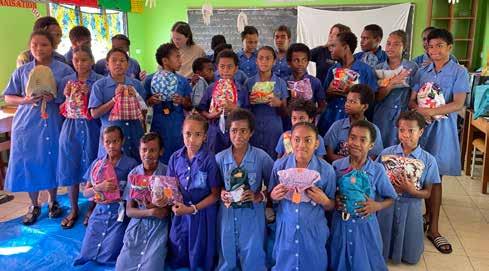
Days for Girls provides the gift of opportunity
Volunteers craft menstrual care kits to help girls stay in school and live with dignity.
By Peri Kinder peri.k@thecityjournals.com
For more than 500 million women and girls around the world, access to menstrual products is nonexistent. The term “period poverty” describes the struggle faced by people who don’t have adequate menstrual supplies and education.
Days for Girls is a global nonprofit offering dignity and health to women and girls by providing sustainable menstrual kits. Volunteers around the world sew, assemble and distribute the kits, allowing girls to stay in school, attend work and alleviate health concerns that arise when menstrual products are unavailable.

Suzanne Walker runs the Midvale chapter of Days for Girls, along with her friend Jennifer Woods and lots of volunteers. The chapter has created and distributed nearly 2,000 kits to Thailand, Mexico, Vietnam, Fiji, Morocco, Zimbabwe, Peru, Cambodia and Nepal.
“We not only sew components, we are also a source of outreach for our community,” Walker said. “We advocate on behalf of Days for Girls International, teaching about its mission and the reasons why there is a need for such an organization to exist. We also conduct work events with local churches and business groups, in which they help create the kits that will then be distributed throughout the world.”
Days for Girls was started in 2008 by Celeste Mergens. She was working at a Kenyan orphanage and found that menstruating girls would sit on pieces of cardboard, often going without food. With cultural taboos around menstruation, some women and girls can’t attend school or work, or even go into a kitchen while on their period.
Mergens created washable, long-lasting pads and underwear, designed to last several years, giving the girls the freedom to leave their rooms, reclaim their dignity and potentially end the cycle of poverty.
“The evolution of this pattern for these kits has changed many times,” Woods said. “They keep making it better and better. They listen to the girls and the moms, and the feedback that people give, and they fix any issues.”
The kits contain two pairs of underwear, two reusable shields, eight absorbent liners, a washcloth and soap for cleaning, and a waterproof bag to hold everything. Colorful fabrics help normalize menstruation and the components dry quickly to allow the women and girls to manage their hygiene. The waterproof bags are also used as a washing device in places where water is scarce.
“Some girls and women walk miles and miles for water,” Woods said. “They have this very small amount of water to use for their cooking and their cleaning, so these bags become little washing machines.”
Walker said it’s a lot of work to create the kits and they have specific instructions to follow to ensure the pieces work together. But she calls it a “labor of love” for the thousands of women and girls their kits have helped over the years. The group holds service projects several times a year, where volunteers sew kit components.
“Even in the United States, there are women who don’t have access to period products,” Walker said. “There are hundreds of stories of lives being changed through Days for Girls. I love going into my community and talking about it, because we don’t talk about it. I talk to a lot of young women’s groups and they are super embarrassed, but they have no idea how lucky they are.”
To learn about volunteering or donating to the Days for Girls Midvale chapter, visit the Facebook page @dfgmidvale. For information about the international organization, visit DaysForGirls.org. l
Millions of women and girls have received menstrual kits from Days for Girls. The Midvale chapter has created and distributed thousands of kits to girls all over the world. (Photo courtesy of Suzanne Walker)
Odyssey House opens new sober living facility in Murray
Salt Lake County, Odyssey House cut ribbon on 20-bed sober living site.
By Shaun Delliskave s.delliskave@mycityjournals.com
Salt Lake County and Odyssey House of Utah officially opened a new sober living facility in Murray on Aug. 27, welcoming community members, state leaders and treatment advocates to tour the site and learn about its mission.
Anchor Point, located at 671 E. 4800 South, adds 20 transitional beds to Odyssey House’s network of sober living homes across the Salt Lake Valley. The program is designed to help individuals maintain long-term recovery while reintegrating into the community after treatment, jail time or participation in Salt Lake County drug court programs.
The new facility is partially funded through opioid settlement dollars, with support from both the state and Salt Lake County. County officials emphasized its role in meeting goals outlined in the Human Services, Homelessness and Criminal Justice Action Plan.
Dignitaries gathered on the front lawn for remarks before a ribbon cutting at the facility’s entrance. Among the speakers were Salt Lake County Mayor Jenny Wilson, Utah State Rep. Jim Dunnigan and Odyssey House President Adam Cohen. A former Odyssey
House resident also shared a personal account of transitioning into long-term recovery.
Following the ceremony, attendees toured Anchor Point and spoke with program staff. The event concluded with a reception offering light refreshments.
According to Randall Carlisle, Media and Community Affairs representative for Odyssey House, Anchor Point will operate under the organization’s highly structured transitional sober living model.
“We have curfews, a supervisor on every site, regular group meetings to talk about any problems our clients are facing, room checks to make sure there’s no contraband, vouchers to cover the first three months of living there, then reduced rates based on a person’s income,” Carlisle explained. “Also regular drug testing.”
Odyssey House currently operates multiple sober living sites, now totaling 120 beds. Carlisle said demand for space remains high. “We have a waiting list for sober living so we are always trying to expand,” he said.
The average length of stay in Odyssey’s sober living facilities ranges from three months to a year, with applicants vetted by the director of transitional living. Carlisle said the organization prioritizes continuity of care.
“Success is measured first and foremost on long-term recovery. Most clients in sober living have jobs and continue their therapy in our intensive outpatient program,” he said.

Each house has a manager, often an Odyssey graduate, reinforcing the program’s emphasis on peer mentorship. “We believe peer support is critical when a client gets to the stepdown stage of sober living,” Carlisle said. He added that clients also have access to long-term graduate support groups and medical care through Odyssey’s Martindale Clinic.
Carlisle highlighted the program’s ongoing collaboration with county reentry services. “We have always been coordinating with county reentry programs like drug court. Many of our clients are still in drug court,” he said. He also pointed to a positive relationship with Murray itself. “We have a great working relationship with Murray City. In fact, sev-
eral of our transitional living facilities have been in Murray for years,” Carlisle said.
Anchor Point is the latest addition to Odyssey House’s efforts to provide stepdown services for individuals in recovery from substance use and mental health crises. With the new facility, leaders hope to address both the immediate demand for sober living and the county’s broader public health and safety goals.
For Odyssey House, the expansion represents another step in building a continuum of care that bridges treatment with community living. As Carlisle summarized, “When clients get to the stepdown stage, our goal is to give them the structure, accountability and support they need to succeed.” l




Salt Lake County Mayor Jenny Wilson, Rep. Jim Dunnigan and Odyssey House representatives cut the ribbon to the new sober living facility. (Photo courtesy Odyssey House)
Murray turns the lights out on Motel 6 redevelopment conversion
Murray City Planning Commission recommends against converting Motel 6 on 6600 South to affordable housing.
By Shaun Delliskave s.delliskave@mycityjournals.com
The Murray City Planning Commission has rejected a proposal to convert the former Motel 6/Studio 6 on 6600 South into a mixed-use affordable housing project, citing concerns raised by residents and the commission’s own review of the developer’s track record. The unanimous vote on Aug. 7 recommended that the Murray City Council deny the rezoning request sought by Ville Property Management.
The project, known as the Ville 66 Project, was pitched by developer Keith Warburton of Ville Property Management. His plan called for retrofitting the long-term stay hotel at 975 E. 6600 South into 102 studio apartments and creating about 5,000 square feet of commercial space from existing rooms. To move forward, Warburton requested that the property be rezoned from General Office to Village Mixed Use, a designation that allows both housing and retail.
City planning staff recommended approval, conditioned on a binding development agreement. Planning Manager Zachary Smallwood told commissioners the project met the

goals of Murray’s mixed-use zoning ordinance. In his report, staff found that the conversion would “facilitate the adaptive re-use of existing commercial structures” and “promote opportunities for life-cycle housing, and housing for moderate income households.”
The staff analysis noted that the property had struggled since losing its Studio 6 motel branding, with “an uptick in crime at this property since losing its branding as a Studio 6 motel.” The city also received complaints from surrounding property owners who “do not feel safe and have observed suspicious activity near the office buildings.”
While planning staff urged approval, resident Sherry Bleazard submitted a detailed written objection questioning both the developer’s record and the suitability of the project’s location.
“It is my humble opinion after researching Mr. Warburton and his failed attempts at developing properties for affordable housing projects, that he is definitely NOT the most trustworthy person to be entrusted with such a large amount of grant money,” Bleazard wrote.
She cited examples of Warburton’s other ventures: Ville 647 in Richfield, which was destroyed in a fire in 2022; Ville 9 in downtown Salt Lake City, where she alleged “construction has been stalled” and “area business owners are complaining that the residents are
trafficking and using drugs;” and the Elko Inn in Nevada, which “on March 6, 2024,…was raided by a SWAT team for drug trafficking violations.”
Finally, she argued that Wheeler Farm, which borders the property, would be negatively affected by the type of housing proposed. “My opinion is that the types of tenants attracted to this type of housing is not a good fit for a facility located right next to a highly-used county park such as Wheeler Farm,” she stated.
After hearing the staff presentation and reviewing public input, the commission voted unanimously against recommending approval. The motion to support the zoning change and development agreement failed without dissent.
The commission’s recommendation now heads to the Murray City Council, which will hold its own public hearing and vote in the coming weeks.
The Ville 66 Project is part of a broader push by Warburton’s Ville Property Management and its parent company ETNA Properties to convert distressed motels into affordable housing across Utah and neighboring states. Proponents argue such adaptive reuse is a cost-effective way to address the region’s housing shortage.
Murray City staff, in recommending approval, emphasized that the project’s design


would include significant commercial space to serve residents and neighbors. “Because of the unusual nature of the request, CED has determined that this is a special case that involves a more thorough review and guardrails to ensure the city is not reasonably aware of the impacts from the proposed project,” the staff report stated.
But the commission’s rejection underscores skepticism about whether such conversions can succeed without broader community confidence.
The Murray City Council will take up the recommendation later this year. Council members are not bound by the Planning Commission’s decision, but they traditionally give weight to unanimous recommendations. l


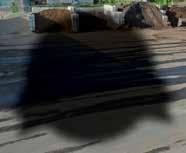







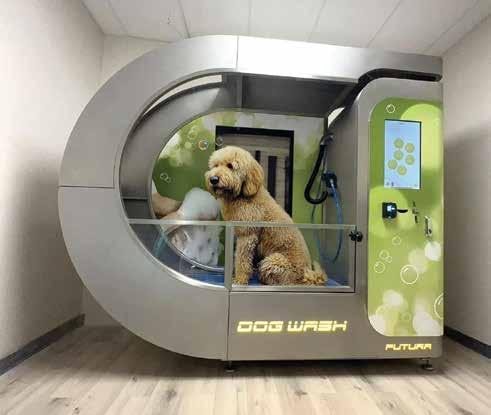




Keith Warburton of Ville Property Management proposes to convert the former Motel 6 into affordable housing. (Shaun Delliskave/City Journals)
Unsafe at any hour: Murray’s 4500 South crisis
UDOT has documented over 322 crashes over a five-year period at 4500 S. State St.
By Shaun Delliskave s.delliskave@mycityjournals.com
Awoman struck twice and left dying in the middle of State Street has forced Murray residents and Utah officials to confront an uncomfortable truth: the intersections of 4500 South and State Street are among the most treacherous in the Salt Lake Valley. The July 31 double hit-and-run, captured on video and released by police, did not just shock the community—it underscored what state crash data and years of local complaints have long made clear.
On that July 31 night, 53-year-old Kimberley Jespersen was hit by a car making a left turn from State Street onto 4500 South. She fell in the crosswalk. A pickup then swerved around the stopped vehicle and struck her again, fleeing without stopping. Both drivers left the scene. Police later released CollisionCam footage of the incident, appealing for tips from the public.
The tragedy brought renewed attention to a corridor already notorious for crashes. A Deseret News analysis of state crash records found 12 auto-pedestrian crashes at 4500 South and State between 2010 and 2016, the second-highest total in Salt Lake and Utah counties during that period. In broader crash counts,
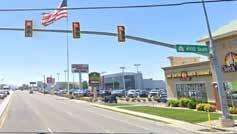
One woman was killed in a double hit-and-run at Murray’s most dangerous intersection—4500 S. State St. (Shaun Delliskave/City Journals)
the intersection has consistently ranked among the county’s leaders. Data from the Utah Department of Transportation (UDOT) shows that State Street through Murray is a dense cluster of collisions, stretching from Edison Street— just north of 4500 South—down through the 4500 South junction.
The reasons are not hard to see. State Street, or U.S. 89, is a six-lane highway carrying tens of thousands of vehicles daily through Murray. It intersects with 4500 South, or State Route 266, a major east-west arterial that feeds traffic from I-15 into commercial districts. Multiple lanes, high turning volumes, closely spaced driveways, and long pedestrian crossings combine to create fertile ground for rearend, angle, and auto-pedestrian crashes.
UDOT acknowledges the tradeoffs in how the lights are timed. John Gleason, spokesperson for UDOT, told Fox13 News: “At other


Grief is an individual journey with a path as unique as each one of us. To o er support and hope, we provide various Grief Support Services for those who are mourning a recent or past loss.





points in the day, it makes more sense to have that yellow caution where you only turn when it’s safe to do so…it’s left up to the driver’s discretion.” At the same time, he stressed the agency’s responsibility to adapt and “…make sure we’re always monitoring our roads, and if a traffic situation changes…we need to make those adjustments as well.”
Responsibility for the intersection lies squarely with UDOT, not necessarily the city of Murray. Because both roadways are state routes, the traffic signals, geometry and safety enhancements fall under state jurisdiction. UDOT’s Traffic Operations Center manages signal timing and can adjust phasing remotely.
What could be done? Transportation safety experts point to well-documented countermeasures. Protected-only left-turn phases during peak hours can prevent conflicts between opposing traffic streams. Leading Pedestrian Intervals give walkers a head start before vehicles move. Raised medians or refuge islands break up long crossings and give pedestrians a safer midway point. Access management, such as consolidating driveways near the stop lines, can reduce the chaos of cars weaving in and out of businesses. Also high-visibility crosswalks, speed management and targeted enforcement round out the list.
Some incremental changes are already planned. UDOT’s “State Street Renewed” work, running from I-215 to 9400 South, in-
cludes resurfacing, curb repair and ADA ramp upgrades—improvements that should improve accessibility and visibility. But for Murray’s deadliest corners, the conversation is shifting toward whether larger changes, like permanent protected lefts and pedestrian priority measures, should be accelerated.
According to a UDOT crash summary table titled “Intersection Crashes at Select Signalized Intersections – 2014-2018,” the intersection of State Street and 4500 South recorded 322 crashes during that five-year span—nearly double the 176 crashes documented at State Street and 5300 South over the same timeframe. This, along with the fatal double hit-and-run on July 31, underscores the intersection’s elevated risk. Additionally, crash-mapping tools from UDOT show a dense cluster of collisions from Edison Street (just north of 4500 South) continuing through the 4500 South junction, suggesting the corridor functions more as a single hazard zone than separate signalized crossings.
Murray police are still seeking information about the drivers involved in the late summer hit-and-run at 4500 South and State Street, urging anyone with tips to contact investigators. For residents wanting a broader view of traffic safety in the city, UDOT’s Interactive Crash Map (available at udps.numetric.net/ utah-crash-summary#/) provide publicly accessible information regarding vehicle incidents in Murray and across Utah. l









Halloween comes to class—with rules
Spooky season is approaching and for elementary schools that means combining costumes, classwork and community with safety.
By Julie Slama j.slama@mycityjournals.com
As about 600 Glacier Hills elementary students parade through a White City neighborhood in costume on Halloween morning, safety remains top of mind for Principal Julie Winfree.
“We will have police officers lead, follow and patrol intersections and we’ll have teachers, aides and extra staff with walkie-talkies walking with the students,” she said, urging parents to ensure kids wear appropriate shoes and coats. “It’s a fun opportunity for the parents and community to sit out on their driveways and see the students parade by; they line the streets.”
Still, she notes, “It’s also a day of learning so we want students to wear costumes they can learn in.”
That means no masks, weapons or facsimiles of weapons—guidelines shared across most Salt Lake Valley schools.
Luke Allen, Granite School District’s associate director of communications, said costumes must follow regular dress code rules.
Those guidelines include students must be fully dressed, with clothing that covers the body appropriately and includes safe footwear. Students also may not cover their face unless it is for religious, health or medical reasons. Costumes or clothing may not display images, symbols or language that depict obscenity, lewdness, hate, violence, drugs, alcohol, tobacco or gang-related activity, and they may not include items that could be used as a weapon. Student attire and expression also must not cause significant disruption to learning.
“Halloween can be a fun opportunity for students to celebrate together, but we remind families that costumes at school
must follow the same rules as everyday attire,” he said. “Our focus is always on ensuring a safe, respectful and positive environment for all students.”
Many of Granite District’s 26,000 elementary students participate in Halloween parades, typically held outdoors, weather permitting.
Canyons School District Risk Manager Ryan Jakeman advises parents to consider different costumes for school and trickor-treating.
“Masks, which block visibility, and facsimiles of weapons are a ‘no-go’ at school,” he said, recommending face paint instead. “While costumes are encouraged, safety is also a priority for students.”
Canyons spokesperson Kirsten Stewart adds: “We’ve found outdoor parades, provided you can identify a safe route, are a great way to involve the community.”
Jordan School District also has shifted most parades outdoors post-COVID.
Jordan District’s Director of Communications Sandy Riesgraf said schools typically remind families: “no masks, weapons or excessive face paint. The school staff needs to be able to identify students.”
Riesgraf added costumes should be wearable all day and follow district dress codes.
At Falcon Ridge Elementary in West Jordan, Principal Aaron Ichimura said dressing up helps build connections between students and administration.
“They get to learn we’re human and enjoy doing the same things they enjoy,” he said. “Halloween traditions are deeply rooted in Utah.”
The school holds a PTA-run festival with students rotating every 30 minutes with seasonal grade-level activities.
“We’ll send out a Parent Square message reminding students not to wear masks, because we want to be able to identify students, no weapons or facsimile of weapons, no blood or vio-
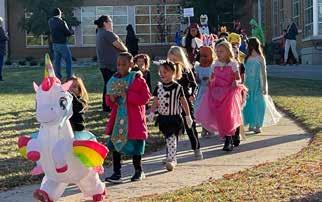
lent costumes,” Ichimura said. “We want Halloween to be a fun time for everyone.”
Like other principals, Ichimura emphasized classroom learning.
“We encourage staff to plan learning activities, and they can be ideas linked to Halloween like stories or math so it can be a creative, fun approach to learning,” he said.
In Murray School District, individual schools set safety guidelines.
“Halloween is a fun and exciting time for our students, and we support school administrators in creating a positive and safe environment by developing traditions and practices unique to their school,” said Doug Perry, Murray District’s communication officer. “We also encourage families and the community to prioritize safety when choosing how to celebrate, both at school and beyond.” l




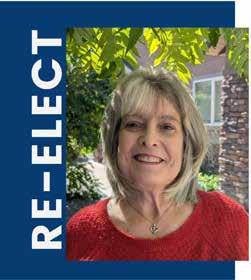

- Aaron Holbrook "With
- Roxanne Nelson

Halloween parades, like this one at Sandy Elementary in 2023, are fun for students and the community, but safety is an important factor, principals say. (Julie Slama/City Journals)

October 2025

FREQUENTLY REQUESTED NUMBERS
Attorney 801-264-2640
Business Licensing 801-270-2425
Cemetery
City

801-264-2637
801-264-2603
Finance Department 801-264-2513 Passports 801-264-2660
FIRE DEPARTMENT
Administrative O ce .......... 801-264-2780 Non-Emergency Calls 801-840-4000
General Information ................ 801-264-2525
Human Resources.................... 801-264-2656 Library 801-264-2580
Mayor’s O ce 801-264-2600 Municipal Court....................... 801-284-4280
PARKS AND RECREATION
Administrative O ce .......... 801-264-2614
Recreation Division 801-264-2614
Museum 801-264-2589
Murray Outdoor Pool 801-290-4190
Murray Parkway Golf Course.... 801-262-4653
The Park Center 801-284-4200
Senior Recreation Center ......... 801-264-2635
POLICE DEPARTMENT
Administrative O ce .......... 801-264-2673
Animal Control/SL County 385-468-7387

Code Enforcement 801-264-2673
Non-Emergency Calls ......... 801-840-4000
POWER DEPARTMENT
Administrative O ce .......... 801-264-2730
After Hours Emergency 801-264-9669
PUBLIC SERVICES
Administrative O ce 801-270-2440
Building Inspection 801-270-2431
Green Waste Trailers ........... 801-270-2440
Planning and Zoning 801-270-2430
Solid Waste 801-270-2440
Water, Sewer, Streets .......... 801-270-2440
Zoning Enforcement ........... 801-270-2426
UTILITIES
After Hours Emergency 801-264-9669
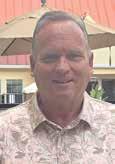
CITY PARKS & REC DEPARTMENT MESSAGE
October in Murray: Spooky Fun & Show-Stopping Entertainment
By Kim Sorensen, Director of Murray City Parks and Recreation Department
October has arrived, and Murray is the place to be! From spooky thrills to family-friendly fun and show-stopping performances, the city is bursting with ways to celebrate the season. Gather your friends, bring the family, and join the excitement. There’s something happening for everyone this month!
Murray Theater Lineup – Tickets at www.MurrayTix.com
The Sun Kings – Thursday & Friday, Oct. 3, 4
A fresh and authentic Beatles experience that captures the energy and timeless music of the Fab Four.
WKLL Radio Murder Mystery Hour – Oct. 10, 11, 13, 16 & 17
Step back in time for this interactive theater performance lled with intrigue, suspense, and vintage radio charm. Every night brings mystery, laughter, and plenty of twists!
Neil Diamond: Superstar Tribute – Friday & Saturday, Oct. 24, 25
Sing along to the hits you know and love in this high-energy, heartfelt tribute to the legendary performer.
Recreation Division Highlights – Tickets at www.mcreg.com
Pumpkin Plunge – Friday, Oct. 10
Kids, grab your swimsuits and dive in! Rescue a oating pumpkin for a unique Halloween splash. 6 p.m.
Halloween Howl 3K & 5K – Saturday, Oct. 11
Dress up (and bring your pup in costume, too!) for this fun run/walk in Murray Park. Enjoy prizes, treats, and tail-wagging fun. 11 a.m.
Pumpkin Races & Plummet – Friday, Oct. 17
Cheer on speedy pumpkin racers or laugh at pumpkin splats! A must-see for pumpkin lovers. 6 p.m.

Trunk or Treat – Thursday, Oct. 23
Wrap up the month with decorated trunks, candy, and family fun. Sign up to host a trunk and compete for “best decorated.” 5:30 p.m.
Community Contests & Exhibits
Haunted Tales Writing Contest
Long from Leavitt Concert –Monday, Oct. 13
Enjoy a free evening of live music for the whole family. 7 p.m. at the Senior Recreation Center.
Dine and Dance – Thursday, Oct. 24
MAYOR’S OFFICE

Brett A. Hales -Mayor mayor@murray.utah.gov 801-264-2600 10 East 4800 South Murray, Utah 84107

Come have dinner and learn some new moves from 1520 Arts! If dancing isn’t your thing, show o your creativity in our Pumpkin Stroll! Display your decorated or carved pumpkin for all to see. A prize will be awarded to the people’s choice winner. 6–8 p.m., City Hall Plaza.
Juried Art Show- Oct. 27 – Nov. 12
Featuring incredible local talent across all mediums. At the Murray Library (open during library hours).
From pumpkins to performances, October in Murray promises memories for the whole family. Mark your calendars, invite your friends, and join us in celebrating a month full of fun!
Billing Questions 801-264-2626 murray.utah.gov

Open to all K–12 students who want to showcase their storytelling skills. Entries due by Oct. 10. For more information, contact rcoates@murray.utah.gov or visit https://www.murray.utah.gov/2143/Haunted-Tales
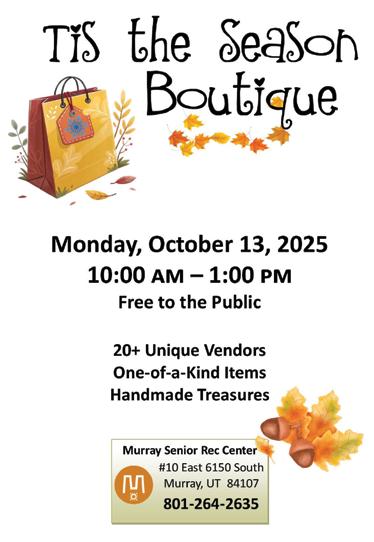
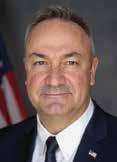
Nine Months In: Lessons from the Council Chambers
When I joined the Murray City Council nine months ago, I brought with me a lifetime of leadership experience—from commanding soldiers in the Army to managing complex logistics in the private sector. But public service at the municipal level has its own rhythm, its own challenges, and its own rewards. These past months have been a crash course in listening, learning, and leading with humility.
Here are a few of the most important lessons I’ve learned:
Local Government Is Personal
Unlike state or federal politics, city government touches people’s lives in immediate, tangible ways. Whether it’s a zoning issue, a tra c concern, or a question about property taxes, residents want to be heard—and they deserve to be. I’ve learned that responsiveness isn’t just appreciated, it’s expected. And when you take the time to listen, people open up about what really matters to them.
Transparency Builds Trust
One of my top priorities has been improving communication between the Council and our residents. I’ve seen rsthand how a lack of clarity can breed frustration. That’s why I’ve worked to make our processes more accessible—whether it’s explaining budget decisions in plain language or advocating for more inclusive public engagement. Trust isn’t built overnight, but it starts with honesty and consistency.
Every Issue Has Layers
From housing development to public safety, I’ve learned that no issue is as simple as it rst appears. There are competing interests, historical context, and unintended consequences to consider. My job isn’t just to vote— it’s to ask the right questions, challenge assumptions, and nd solutions that re ect the values of our community.
Balancing Public Service and Family
Serving on the Council while supporting my daughter Evelynn’s competitive dance career has reminded me that leadership isn’t just about policy—it’s about prioritiesl;.,.l.l,,ll,,,,,,,,,. I’ve learned to navigate late-night meetings and out of town competitions, and I’ve come to appreciate the strength it takes to show up fully in both roles. Family keeps me grounded, and it’s a constant reminder of why I serve.
Community Safety Requires
I’ve worked with residents to raise awareness and promote proactive safety measures. Our community is strongest when we look out for one another.
Serving on the Murray City Council has reminded me that real leadership isn’t about titles—it’s about trust, transparency, and showing up for the people you represent. I’m proud of the progress we’ve made, humbled by what I’ve learned, and energized by the road ahead. Together, we’re not just shaping policy—we’re shaping the future of our city, one conversation at a time.
—Scott
Goodman, Murray City Council – District 3
Murray Senior Recreation Center
10 E 6150 S, Murray, Utah 84107 • 801-264-2635 mcreg.com • seniorrec@murray.utah.gov
Mon-Fri 8:00 a.m. – 4:30 p.m.
Thurs 8:00 a.m. – 9:30 p.m. • Closed Sat and Sun CHEF OMAR LIMON
DAILY LUNCH
Date: Tuesday through Friday
Time: 11:30 a.m. – noon
Cost: Cost is $6; prior reg. not required SPECIAL EVENT
‘TIS THE SEASON BOUTIQUE
Date: Monday, Oct. 13
Time: 10:00 a.m. – 1:00 p.m.
Cost: Free for the Public CLASSES
CERAMICS
Date: Tuesday and Thursday
Time: 9:00 a.m. – noon
Cost: $2 each class plus cost of supplies
GRIEF SUPPORT
Date: Friday, Oct. 10 and 24
Time: 10:30 a.m. – 11:30 a.m.
Cost: Free
VITAL AGING: Scams and Identity Theft
Date: Friday, Oct. 24
Time: 1:00 p.m. – 2:00 p.m.
Cost: Free
HISTORY CLASS: Origins of Everyday Things
Date: Tuesday, Nov. 4
Time: 10:00 a.m. – 11:00 a.m.
Cost: Free
SCIENCE CLASS: Nitrogen, Lithium, and Gold
Date: Thursday, Nov. 6
Time: 10:30 a.m. – 11:30 a.m.
Cost: Free
CLIMBING THE PEAKS: Pico de Orizaba
Date: Friday, Nov. 7
Time: 10:30 a.m. – 11:30 a.m.
Cost: Free
DANCE
BEGINNING LINE DANCE INSTRUCTION
Date: Tuesdays
Time: 1:15 p.m. – 1:45 p.m.
Cost: $5 for the month; register now THURSDAY EVENING SOCIAL DANCE
Live Music provided by Tony Summerhays
Date: Thursdays
Time: 7:00 p.m. – 9:30 p.m.
Cost: $5
FITNESS: Daily Fitness Classes – check our current newsletter for the schedule and fees PROGRAMS BINGO
Date: Wednesdays and Fridays
Time: 12:45 p.m. – 2:45 p.m.
Cost: Free, donations are appreciated BRIDGE LESSONS
Date: Mondays
Time: 1:00 p.m. – 3:00 p.m.
Cost: Free CANASTA
Date: Tuesdays
Time: 12:30 p.m. – 4:00 p.m.
Cost: Free CHESS
Date: Thursdays
Time: 12:30 p.m. – 3:30 p.m.
Cost: Free
HAND AND FOOT CARD GAME
Date: Mondays
Time: 12:30 p.m. – 4:00 p.m.
Cost: Free
MEXICAN TRAIN DOMINOS GAME
Date: Thursdays
Time: 12:30 p.m. – 4:00 p.m.
Cost: Free
HEALTH SERVICES
HAIRCUTS
Date: Wednesdays
Time: 9:30 a.m. – 12:30 p.m.
Cost: $12; advance appointment required CLUBS
THURSDAY QUILTERS
Date: 2nd Thursdays each month
Time: 12:30 p.m. – 2:00 p.m.
Cost: Free
MURRAY SENIOR CHOIR
Date: Thursdays
Time: 4:00 p.m. – 6:00 p.m.
Cost: Free

CITY COUNCIL

City Council District #1 Paul Pickett
801-743-0911
ppickett@murray.utah.gov
Council District 2
Pam Cotter
801-541-8364
pcotter@murray.utah.gov
Council District 3
Scott Goodman
801-699-6631
agoodman@murray.utah.gov
Council District 4
Diane Turner
801-635-6382
diane.turner@murray.utah.gov
City Council District #5 Adam Hock
801-557-1346
ahock@murray.utah.gov
Executive Director Jennifer Kennedy Office: 801-264-2622
jkennedy@murray.utah.gov

Telephone Agenda Information 801-264-2525


OCTOBER 2025


























Mu ray
murray.utah.gov murray.utah.gov






Mu ray City



City Recreation

Recrea

THE PARK CENTER THE PARK CENTER
Friday, October 10
6:15pm - Leisure Pool Plunge
6:25pm - Lap Pool Plunge
$4 Residents |$6 Non-Residents
Friday, October 17
6:00pm - Costume Contest - Free 6:10pm - Pumpkin Races $2/$3
6:30pm - Pumpkin Plummet - Free Option to purchase Pumpkin Kits
Tuesday and Thursday
3:45, 4:20, 4:55, and 5:30pm 8 lessons / $40 res & $50 non-res
p k i n p l u n ge pumpkin plunge s w i m m i n g l e s s o n s swimming lessons Y o u t h v o l l e y b a l l Youth volleyball p u m p k i n r a ce s pumpkin races
Saturdays, Oct 25 - Nov 22
Ages 3-9 | Park Center
$40 Residents
$50 Non-Residents






Saturday Games
November 1 - December 13
6 games + 2 Utah Jazz Tickets, Coed
Ages 8-11 (+ 1 weeknight practice)
$68 Residents | $78 Non-Residents
Ages 12-14 (+ 1 weeknight practice)
$78 Residents | $88 Non-Residents
Tues Coed Ages 6-7
$3 RES / $4 NON-RES
OR Monthly Lessons
Mondays, Nov 3 - Dec 8
Ages 9-11 | 5:30-7PM
Ages 12-14 | 7:15-8:45PM
$40 Residents
$50 Non-Residents





October 28-December 2 Practice on game day
$63 Residents | $73 Non-Residents
Wed Coed Hoops Clinic Ages 4-5
October 29 - December 10
$58 Residents | $68 Non-Residents
Boys High School
December 6 - February 7 (7 games/tourney)
$90 Residents | $100 Non-Residents
Ages 14-15 & 16-18
Also offering a Jr. Jazz League for ages 5-13 beginning in January 2025.






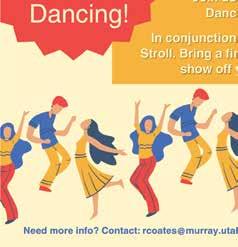

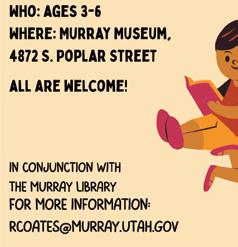






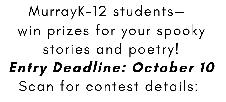







HAUNTED TALES - LIGHTS, CAMERA… AAAAH!
Cue the ghosts, ghouls, and ghastly good stories! In celebration of Murray Theater’s re-opening, Haunted Tales is casting for the spookiest scripts in town. Enter if you dare! Student writing contest due October 10. Set the scene for the rules here: Haunted Tales Contest. https://www.murray.utah. gov/2143/Haunted-Tales
It’s opening fright at the Murray Theater! We’re celebrating with our student writing contest, Haunted Tales! Here’s your chance to tell a reel scary story… Set the scene for the rules here: Haunted Tales Contest. Deadline: October 10 https://www.murray. utah.gov/2143/Haunted-Tales




MURRAY JURIED ART SHOW OCT. 27 – NOV. 12, 2025
Celebrate local creativity at the annual Murray Juried Art Show, featuring the artistic talents of Murray residents, both amateur and professional, ages 18 and older. This year’s show will include entries in a variety of categories, including Watercolor, Oil and Acrylic, Graphics (pen, pencil, pastel, ink), Original Photography, Mixed Media, Ceramics, Woodwork, and 3D.
The show will be on display during regular library hours at the Murray Library. Artists may drop o their work on October 23 from 4:00–7:00 PM. If you are unable to make this time, please contact us to make alternative arrangements to submit your art.
Go to https://www.murray.utah.gov/2144/ Juried-Art-Show
Twenty years in the making, WKLL Radio Murder Mystery Hour is back! Written by siblings Tabitha and Joseph Thompson, this 1940s-style radio whodunit has been expanded from a 16-page dinner theater show into a fulllength stage production. Originally performed in 2005, it’s returning for the grand reopening of the beautifully renovated, art-deco Murray Theater—built in 1938 and the perfect backdrop for this clever, comedic mystery. Don’t miss the fun and suspense as the Thompsons’ playful spirit brings the murder mystery to life on stage. Performances run Oct. 10, 11, 13, 16, and 17. Tickets at www.MurrayTix.com.

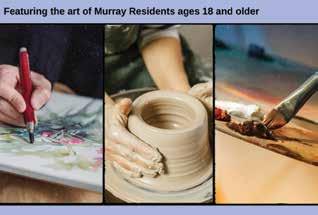

2025 GENERAL ELECTION VOTER GUIDE
MURRAY VOTING INFORMATION
In Murray, seven candidates are campaigning for a seat on the city council. You’ll learn more about each of them as you continue to flip through this Voter Guide.
• Bruce Turrner & Brett Hales are running for Mayor.
• Pamela Cotter & Jared Eborn are running for District 2.
• Clark Bullen & Ben Peck are running for the District 3 council seat.
• Diane Turner is running for the District 4 council seat.
Throughout the greater Salt Lake County area, voters are encouraged to pay attention to important calendar dates (like mail-in deadlines) and locate the most convenient ballot drop box.
Residents have a few different options to submit their ballots, after receiving their ballot and prepaid envelope in the mail close to two weeks before the election date.
For voters planning to vote-by-mail, ballots must be received by 8 p.m.. on election day (postmarks don’t count). In other words -- mail early.
In previous election cycles when residents were able to postmark their ballots on the day of the general election. Per the recently passed H.B. 300, voters do need to make sure their ballots are physically ‘in-hand’ at the Salt Lake County office on election day.
While registered voters do have the option to send in their vote-by-mail ballot before Nov. 4, they also have the option to vote in person. Check the accompanying list of Vote Box locations to find the ballot box nearest you. Similar to mail-in voting, ballots must be dropped off before 8 p.m. on election day.
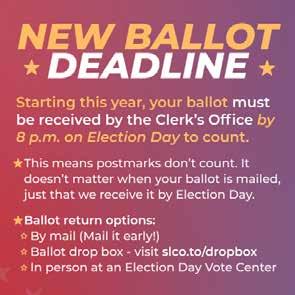
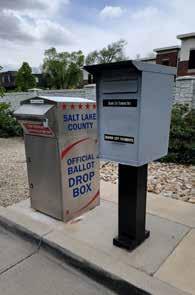
SALT LAKE COUNTY VOTING INFORMATION
Hey Voters! Please review the following voting information directly from Salt Lake County before submitting your ballot.
Nov. 4 is the General Election - Vote Centers and drop boxes will close promptly at 8:00 p.m.
Important Dates
Oct. 10 - Salt Lake County will host Logic & Accuracy Tests where the public is invited to attend live demonstrations of voting equipment.
Oct. 14 - Ballots being to be mailed (21 days before the election as per Utah’s legislation).
Nov. 18 - Board of Canvassers Meeting where each city will certify results after presented to the City Recorders.
Vote Box locations:
Residents can vote by mail or in-person at various drop box locations throughout Salt Lake County:
County - Salt Lake County Government Center (2001 State St.)
Cottonwood Heights - City Hall (2277 Bengal Blvd.)
Draper - City Hall (1020 Pioneer Rd.)
Holladay - City Hall (4280 S. 2300 E.)
Herriman - City Hall (5355 Main St.)
Midvale - City Hall (7505 Holden St.)
Millcreek - Common (1354 E. Chambers Ave.)
Murray - Post Office (5025 State St.)
Sandy - City Hall (1000 Centennial Pkwy.)
Sandy - Senior Center (9310 S 1300 E)
South Jordan - City Hall (1600 W Towne Center Dr.)
South Salt Lake - Granite Library (331 S. 500 E.)
Riverton - City Hall (12830 S Redwood Rd.)
Taylorsville - City Hall (2600 W Taylorsville Blvd.)
Wet Jordan - City Hall (8000 S Redwood Rd.)
West Jordan - Ron Wood Park (6000 W New Bingham Hwy.)
West Valley - City Hall (3600 S Constitution Blvd.)
Register to Vote:

Voter Registration website
Residents can register to vote online up to 11 calendar days before the election (before 5pm). Registration must be submitted and received before Tuesday, Oct. 28 to receive a ballot in the mail. A valid form of ID, accurate address information, and date of birth is required to register. Residents can register either: online by visiting the State of Utah’s website (see adjacent QR code); through mail by filling out the Formulario de Inscripcion por Correspondencia Para Votantes (Voter Mail-In Registration Form) found on the County’s website; or in-person at the 2001 S. State St. office. Same-Day registration options will also be available at vote centers. Learn more about voting information through Salt Lake County’s website at: saltlakecounty.gov/clerk/elections. Or by directly emailing: vote@saltlakecounty.gov.
QUESTIONS
MURRAY MAYOR

Do you believe current property tax revenue is being used effectively? How so?
Thinking about fiscal responsibility—what values should your local budget reflect? How do you plan to balance those values?
What systems would you support to hold local officials accountable when transparency standards aren’t met?
BRUCE E. TURNER
bruceturnerformurray.com
I do not believe our tax dollars are being used effectively. Our taxes have been raised every year except for election years. Not only that, but millions are also spent on restoring old buildings such as the Murray Theater, Murray Mansion and the Armory building. The Armory building was used by the parks department, so the taxpayers had to build a new garage for the parks department…. As mayor I will use our tax money to the benefit of everyone....
We owe it to the citizens we represent to make sure we spend their money in a way that reflects the need of the taxpayers but should reflect what the government should actually be spending money for. There is no reason departments trade in perfectly good equipment for new equipment to get the same brand name on all equipment…. The city spends millions of dollars on Christmas decorations for city hall. These items are just a little of the poor spending habits our city has gotten into. Our enterprise funds are being allowed to take money from their reserves instead of saving for projects. I will make sure our enterprise funds are building their reserves, so we do not need to bond for projects. It is as simple as doing your household budget; if we do not have the money we do not run out and bond for it, we save for projects, that is what the City’s five-year plans for each department are for.
When elected mayor it is one of my goals to meet with citizens in neighborhood town hall style meetings. In my opinion, this lets citizens discuss issues they are having in their neighborhoods such as any construction issues, police issues or road issues. As mayor, I need to be able to listen and find ways to help our citizens with any issues they may be having. I believe this brings trust and understanding to all residents within our city. I believe we as elected officials should be open about everything we do. In my opinion, meeting with the citizens in this way helps do that.
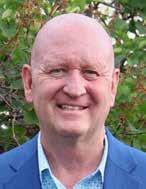
I believe Murray has been very responsible with how property tax revenue is used. We’ve kept services strong: public safety, parks, roads, and essential city functions while making sure taxpayer dollars are spent carefully and efficiently.
It’s worth noting that for tax year 2024, Murray had the lowest property tax rate in all of Salt Lake County. That shows we’ve been able to provide high-quality services without placing an undue burden on residents. My commitment is to continue using tax dollars wisely, keeping Murray both affordable and well cared for.
Murray’s budget’s under my leadership reflects these enduring values:
• Stewardship. Spending every tax dollar wisely and avoiding waste.
• Transparency. Keeping priorities clear and costs under control. Legacy. Completing community priorities like the Murray Theater, Murray Museum, and Murray Armory during my administration.
• Sustainability. Planning for today while protecting Murray’s future.
• Fairness. Investing in every neighborhood and directing resources where they’re needed most.
Looking forward, I’ll keep Murray living within its means through responsible, target-based budgeting. We’re staying competitive by supporting the skilled employees who deliver the services you count on. We’re making smart investments in roads, parks, public safety, and facilities. We’re fixing problems before they become expensive emergencies. And we’re using reserves carefully while limiting rate increases to only what’s truly necessary.
Transparency is the foundation of trust between residents and our city. As mayor, I’ve worked to make Murray government more open and accountable, and I’ll keep pushing our standards higher.
We already broadcast and archive all City Council and Planning Commission meetings online…. We’ve expanded public access to our budget documents, in fact anyone can review line by line where your tax dollars go. If transparency standards aren’t met, I support clear systems of accountability: independent audits, required public reporting, and stronger enforcement of state open meeting laws. Most importantly, I believe in direct communication, whether at public meetings, neighborhood gatherings, or through digital platforms, so residents have a voice and we are held responsible… I will work to keep Murray open, responsible, and transparent.
How will you prioritize and protect proper historic restoration of existing structures?
It is my belief - and many citizens I have spoken to agree - that Murray City has overspent on saving historic buildings. If a developer would like to come in and purchase historic buildings in our city and restore them, I am all for that happening. I do not believe any more taxpayer money should be spent on restoring or purchasing historic buildings.
Murray’s history is special, and protecting it has been a priority during my administration. We’ve invested in historic preservation and delivered results the right way. The Murray Museum reopened its doors in 2025 in the Cahoon Mansion ... In September 2025, the Murray Theater, listed on the National Register of Historic Places, reopens…. We’ve restored the historic Murray Armory… this new event venue is generating significant revenue for the city while offering a great discount for residents.
Each of these projects reflects years of planning, careful investment, and a commitment to proper preservation. By leveraging city resources and securing crucial grants, we’ve shown that preservation can honor our past and serve future generations.
QUESTIONS
Sourced directly from our readers
Do you believe current property tax revenue is being used effectively? How so?
MURRAY DISTRICT 2
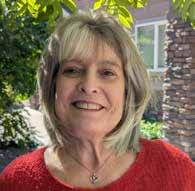
PAMELA COTTER
pam4murray.com
Murray City works with each department head to carefully determine their needs in order for the city to present a budget for the year. We are then very careful to stay within that budget.
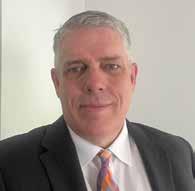
Yes, I believe Murray has generally used property tax revenue effectively to fund essential services such as public safety, parks, libraries, and infrastructure maintenance. These are the core responsibilities of a city, and Murray has managed them responsibly without dramatic increases in tax rates compared to neighboring cities.
That said, I also see opportunities to improve how those dollars are prioritized. As our community grows and ages, we need to ensure investments are forward-thinking - maintaining safe neighborhoods, preserving green space, and modernizing infrastructure - rather than simply reacting to immediate needs. Effective use of tax revenue should always be transparent, accountable, and focused on long-term benefits for residents.
Thinking about fiscal responsibility—what values should your local budget reflect? How do you plan to balance those values?
The budget should reflect the needs of citizens and businesses within Murray. We stay within the budget to meet those needs.
What systems would you support to hold local officials accountable when transparency standards aren’t met?
Murray already has an auditing system that takes place every year. Meetings are all streamed on Murray’s YouTube channel and the minutes of each meeting are on Murray City’s website.
A city budget is more than numbers on a page - it’s a statement of values. Murray’s budget should reflect priorities like safety, sustainability, accessibility, and fairness. That means funding police, fire, and emergency services while also investing in parks, trails, clean water, and infrastructure that improve everyday life. It means supporting economic development in a way that lifts small, locally-owned businesses and creates opportunity without sacrificing our neighborhoods’ character. Balancing these values requires listening to residents, carefully weighing needs against resources, and being transparent about trade-offs. I believe in proactive planning so that we’re not scrambling to fix problems after they arise. By looking at long-term impacts and keeping equity at the forefront, we can make sure the budget serves all residents - young families, seniors, and everyone in between.
Transparency and accountability are cornerstones of good government, and Murray residents deserve to know how decisions are made and how their tax dollars are spent. When transparency standards aren’t met, trust in government erodes. I would support stronger systems such as clearer public reporting on budgets and contracts, timely posting of meeting agendas and minutes, and easy-to-access digital tools for residents to follow city business.
I also believe in building a culture of accountability among elected officials themselves. That means committing to open communication with residents, encouraging robust public comment, and ensuring independent oversight through audits or citizen advisory boards when needed.
Personally, I pledge to lead by example - making my own communications, votes, and reasoning fully open to the public so residents always know where I stand and why. I also pledge to provide common-language reports of each city council meeting and other meetings whenever possible so Murray residents have a more clear understanding of what discussions and decisions are being made that impact their daily quality of life.
What is your stance on local government cooperation with ICE?
I represent EVERYONE within my district. I have no desire to get Murray involved with national issues like immigration and ICE.
I am strongly opposed to Murray police partnering with ICE or DHS. Local law enforcement’s role is to keep our neighborhoods safe, not to enforce federal immigration policy. Agreements with ICE undermine community trust, especially among immigrant families, who may then hesitate to report crimes or seek help when needed. They also pull limited resources away from the core mission of protecting residents and building safe, thriving neighborhoods.
Some nearby cities, such as Riverton, have chosen to align with ICE under the direction of extremist leaders. That approach divides communities, erodes trust, and makes everyone less safe. Murray should take the opposite path—embracing transparency, fairness, and inclusion. Our city should be a welcoming place that values diversity and equity, where the police are trusted partners to all residents. By rejecting ICE partnerships, we strengthen both public trust and public safety. I am grateful for the thoughtful message from the Murray City Police Department stating they have no intention of working alongside any federal agencies to enforce immigration law.
MURRAY DISTRICT 3

Do you believe current property tax revenue is being used effectively? How so?
Thinking about fiscal responsibility—what values should your local budget reflect? How do you plan to balance those values?
I believe that every dollar we get from our citizens is precious and to be spent with the utmost care. Being good financial stewards of the dollars sacrificed for the betterment of our community is arguably the most important job of elected municipal officials. Let’s go through the city budget and each department systematically, looking at where money is spent and where we could be spending more efficiently. A regular audit schedule that does a deep dive on each department should be our best practice. We should share all of this information with the citizens and seek their input. For example: are we spending too much on out-of-state trainings? How much are other cities of a similar size and structure spending? Is there a way to save money through more in-state and virtual trainings or sending fewer people? I would like to dig into these types of issues with our finance department. I am uncertain of specific areas where the city is overspending currently, but I would like to find out if there are any and implement a plan to spend more wisely.
We need to spend each tax dollar with gratitude and care. We need to make sure that our spending priorities align with our residents’ priorities. We should try to minimize any tax and fee increases but make sure we are fully funded and staffed in crucial departments like the Police, Fire, Power, and Public Works departments. We need to be saving for and consistently keeping our infrastructure up to date. We need to invest in redevelopment areas like historic downtown to improve its tax revenue generation potential and provide a destination with amenities for residents and visitors to enjoy. When improving and increasing our public amenities, such as the ones for parks and recreation, we should seek additional funding sources, including grants, private donations, corporate sponsorships, community-wide giving, impact fees, etc., to offset as much expense as we can. Residents should be an integral part of the budgeting process to help us balance these values and keep the city in check.

I believe Murray has generally managed our city’s finances well, maintaining healthy reserves and strong bond ratings that save taxpayers money. However, there’s always room for improvement, and I look forward to using my skills during budgeting to maximize efficiency. While we’ve effectively maintained infrastructure, public safety, and parks, we could better leverage technology to streamline services, invest in energy-efficient upgrades like LED lighting, and shift to preventive rather than reactive maintenance to reduce long-term costs. My approach would include regular performance audits, zero-based budgeting principles where appropriate, regional partnerships to share service costs, and ensuring capital projects deliver measurable community benefits, because residents deserve transparency and accountability in how their property tax dollars are spent.
I believe that our budget should focus on decreasing the cost of living, protecting our community, and improving our quality of life. To decrease the cost of living we should make sure that our government is efficient so that we can keep taxes as low as possible. Protecting our community obviously includes providing sufficient resources for public safety to our Police and Fire Department. It also means using city resources to improve street safety, through traffic calming measures like speed bumps, bulb-outs, raised cross-walks, and protected bike lines. These interventions are proven to work to reduce speeding and save lives and we have the resources to implement them. Finally, we should be using our city budget to improve the quality of life for all residents, that means investing in our parks and recreation, our arts programs, and our senior center.
What systems would you support to hold local officials accountable when transparency standards aren’t met?
How will you prioritize and protect proper historic restoration of existing structures?
As a council, we need to over-communicate and educate. We need to provide information early and often. We need to use many different communication methods to meet people where they are. We need to be readily available to listen to and address citizen needs. If we fail to be transparent, we should be held accountable by the citizens of Murray. I would love to see neighborhood/community councils formed, maybe 4-5 per City Council District. These smaller groups can represent the needs of the citizens in that area and hold their elected representative accountable to the promises they have made.
We should preserve our historic buildings. We do not have to be the ones to pay for restoration. We can put historic protections on our buildings and let private investors restore them to their original beauty. Murray did this with the Murray Chapel. They sold it to the owner of the Tea Rose Diner, who will revitalize it into the beautiful new home of the Tea Rose. Our historic buildings are what give us a sense of place. They are an integral part of downtown Murray. We want the downtown area to be a destination, a town square where people want to gather. Our historic buildings set us apart. They will attract people from all over the valley to spend time and money.
I am committed to ensuring transparency and accountability in our city government. I believe that residents deserve to know what our city is doing, how officials came to those decisions, and why those choices were made. Too often, important decisions are made behind closed doors without adequate public input or explanation. I will always advocate for open processes, clear communication, and accessible information that allows every resident to understand how their government operates. I will fight for full transparency and will use the powers of my office to share information with the public so that they can hold their elected officials accountable.
I am committed to preserving and protecting the unique character that defines Murray as a special place to call home. That includes protecting our historic buildings that tell the story of our community’s rich heritage. Whenever possible the city should work to preserve and restore historic buildings, like they have done with the Murray Mansion, Armory and Theater. These create amazing amenities for the community while preserving our history. Prioritizing fiscal responsibility with every opportunity, I will encourage our collaboration with nonprofit partners, the state and federal government that can support historic preservation projects in our city.
Senior show demonstrates the art of aging brilliantly
The exhibit honored the beauty of experience and lifelong expression.
By Peri Kinder peri.k@thecityjournals.com
Abroken swing hangs from a tree branch, next to an empty house depicted in colors of brown and gray. The picture is titled “Where Have All the Children Gone?” and was painted in watercolor by Millcreek resident Ralph Morelli to depict the loneliness he felt when he didn’t visit with his children and grandchildren.
Morelli’s painting was one of more than 200 entries in the third annual Senior Art Show, sponsored by Salt Lake County Aging Services. Held at the Salt Lake County Government Center (2001 S. State St.), the display featured art in every medium, created by seniors aged 60 and up from around the county.
“Art allows us to express feelings that we might otherwise not be able to give verbally and that’s why I believe it’s so important,” Morelli said. “My art is called emotionalism, because I’m not going for realism. I can express myself with just a few brush strokes. That’s why I think art is important. It allows us to tap into that inner self.”
May 23rd
Golden Corral, 665 East 7200 South, Midvale
The show included displays of pottery, watercolor paintings, sculpture, needlework, quilts, oils and acrylic paintings, photogra-



phy and carvings. Many of the works were done at county senior center locations.
Afton January works with the county’s aging services program. She said the pop-up gallery is a fun way to bring exposure to artwork created by the state’s seniors and give them a chance to show off their talents. Last year’s event had fewer than 90 entries, but the 2025 show had more than double that number.
“It’s frankly a smashing success this year. The skill level is off the charts,” January said. “It’s one of those events that’s been gaining momentum, because it’s a fun opportunity for folks, especially our senior center participants, who represent most of the artists here, to take what they do at those centers and bring it into the community in a way that really feels intergenerational and community spirited. And it’s a fun opportunity for our older adults.”
Millcreek resident Eve Cole entered several artworks at the show, including a drop-pour painted vase and picture, and a framed arrangement of dried flowers. Cole said her sister-in-law got her interested in art during COVID, so they FaceTimed together while creating fun art pieces.
Her painting, “Black Bird in Flight,” was made with a drop-pour background, accented with black and white.
“I showed it to my husband and he said, ‘It’s birds flying.’ I never even would have
Dinner Seminar
Learn more about AdvancedFuneral Planning, Wills, Trusts, Burial Plots, and Cremation

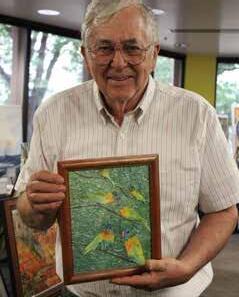
thought of that,” Cole said. “It’s just so rewarding. It just makes me happy.”
More than 300 visitors at the art show voted on their top three favorite entries. The Director’s Choice winner was Dewey Hansen (River’s Bend Senior Center) and the top three vote recipients were Deborah Chiquito (Riverton Senior Center), Shu Yamamoto (Taylorsville Senior Center) and Margi G Owens (Kearns Senior Center).
“Our older adults, many of whom are retired, get to showcase their work and feel like they’re a part of something big and public,” January said. “It gives them some recognition.” l



The Director’s Choice winner of the Salt Lake County Senior Art Show was Dewey Hansen, a regular attendee at the River’s Bend Senior Center in Salt Lake City. (Photo courtesy of SLCounty)
Eve Cole holds her art show entry, “Black Bird in Flight.” The Millcreek resident started painting during COVID. (Peri Kinder/City Journals)
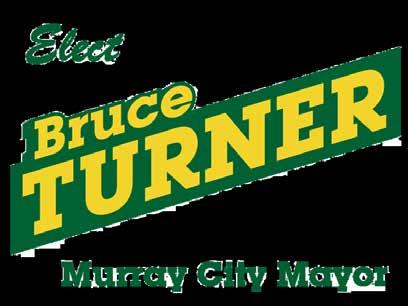

Murray primary results highlight candidates—and realtors’ influence
Financial disclosures show Salt Lake Board of Realtors among the largest donors across mayoral and council races.
By Shaun Delliskave s.delliskave@mycityjournals.com
Murray City’s 2025 primary election, held Aug. 12, drew a modest but notable turnout and set the stage for a November contest where campaign finance may prove just as consequential as policy. Nearly 30% of registered voters participated, with 8,613 ballots cast, according to official results.
In the mayoral race, incumbent Brett Hales advanced comfortably with 58.8% of the vote. Bruce Turner secured second place at 24.6%, edging out Jeff Evans, who drew 16.6%. The two remaining candidates will now compete in the November general election.
Two city council seats also appeared on the primary ballot. In District 2, incumbent Pam Cotter led the field with 45.8%. In tight competition to complete the ballot, Jared Eborn with 24% to former City Councilor Dale Cox 20.5%. Cox and Aaron Holbrook, who received 9.7% of votes, were eliminated.
In keeping Murray’s tradition of tossing out appointed city council members, District 3’s Scott Goodman will lose his seat after securing 18.3% of the vote. Clark Bullen topped the race with 44.7%, advancing alongside Ben Peck, who garnered 27.7%. Leeann Parker Read received 9.3%.
According to Aug. 5 financial disclosures, filed with the city before the primary, reveal a campaign environment shaped by three distinct funding patterns: large institutional donations, organized labor support and candidates relying heavily on their own checkbooks.
Hales, the sitting mayor, raised just under $8,000. His campaign was buoyed by a $4,500 contribution from the Salt Lake Board of Realtors, one of the most prominent institutional donors across all races.
Bruce Turner’s campaign, by contrast, relied almost entirely on self-financing. Of the nearly $13,000 reported, more than $12,000 came from loans Turner made to his own committee. The rest consisted of small contributions in the $25 to $300 range. Evans, who failed to advance, followed a similar pattern: his $6,900 in receipts included a $3,700 personal loan.
In District 2, the most significant financial disparity emerged. Eborn reported $5,215 in contributions, $4,500 of which came from the Salt Lake Board of Realtors. Cotter raised about $3,100, largely through personal funds. But Cox, despite finishing

outside the top two, reported by far the largest war chest—more than $20,000. His contributions included a $4,000 check from the Realtors, but Cox, the former head of Utah’s AFL-CIO, received several significant contributions from labor groups. Holbrook posted a total of $2,616 in contributions received.
In District 3, candidates differed as much in how they raised money as in how much they collected. District 3 represents downtown Murray, the site of several new developments. Outgoing city councilor Scott Goodman listed a $4,500 contribution from the Realtors. Ben Peck assembled $5,700 augmented by $1,500 from the Realtors. Clark Bullen reported $4,925, also with $1,500 from the Realtors, while Leeann Parker Reed, reported $934, placing well behind the frontrunners and the only district candidate without a Realtor contribution.
Diane Turner, the current District 4 council member, will not face a challenger after Adrian Lambrinos withdrew, leaving her unopposed.
The Salt Lake Board of Realtors, established in 1917, is a trade association representing real estate professionals across the Wasatch Front. The organization provides continuing education, legal support and professional services for its members. It also operates a political action committee and frequently contributes to local campaigns.
In Murray’s primary, the group’s financial presence was unmistakable. The Realtors contributed at least $4,500 each to Hales and Eborn, $4,000 to Cox and Goodman, and $1,500 apiece to Peck and Bullen. Their donations made the association the largest single institutional player in the election. In sum, the group donated $16,000 toward Murray candidates.
The organization’s stated mission emphasizes advocacy, education and the defense of property rights. Its 16-member board of directors includes representatives from major brokerage firms, and it often participates in municipal debates
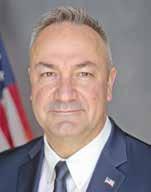

over housing, zoning and development.
The general election, scheduled for Nov. 4, will feature head-to-head contests in the mayoral race and in council districts 2 and 3.
Utah makes voter registration accessible through several methods—online, by mail or in person. Residents can register online at voter.utah.gov using a valid Utah driver license or state ID, provided their address is current with the DMV; otherwise, they must print, sign and mail the form. Voters may also register by completing a paper application and sending it to their county clerk’s office, which must re-
ceive the form no later than 5 p.m. 11 days before Election Day.
For those who miss the deadline, in-person and same-day registration are available either during early voting or on Election Day itself. In those cases, voters must cast a provisional ballot and present one primary photo ID—such as a driver license—along with proof of residency, like a utility bill or lease agreement. This range of options is designed to make registration straightforward and widely accessible. l





Murray City Council races: Pam Cotter vs. Jared Eborn (District 2); Clark Bullen vs. Ben Peck (District 3); Diane Turner (District 5, unopposed). (Shaun Delliskave/City Journals)
Incumbent Mayor Brett Hales will face challenger Bruce Turner in the general election. (Shaun Delliskave/City Journals)
Scott Goodman lost his bid to retain his District 3 city council seat. (Shaun Delliskave/ City Journals)
Cottonwood High theatre season puts a twist on classic tales
Through reimaging classics, theatre students are exploring what it means to bring a story to life.
Julie Slama j.slama@mycityjournals.com
Cottonwood
High’s theatre season will feature well-known stories with creative twists, allowing students to explore their talents in fresh ways.
“It’s a year of story books, but with a unique twist on them, which will be so cool,” said Cottonwood High theatre teacher and director Adam Wilkins. “All year it’s stories, but told in different, innovative and fun ways.”
The season kicks off with the 16-member improv team performing at 7 p.m., Oct. 23 at the school, 5715 S. 1300 East. Tickets are $5, with monthly shows to follow.
On Oct. 27, from 6-8 p.m., the school will host a free Haunted Hallway event, with adjustable spookiness levels, offered alongside an indoor trunk-or-treat organized by Latinos In Action.
“Haunted Hallway started off as a small little party we did for my theater students, and then it just morphed into something we did for our performing arts department, and then it changed into the combined activity with LIA (Latinos In Action)—and it’s so
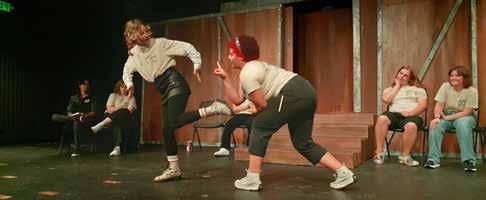
fun. It grows bigger and better every year,” he said.
The fall musical, “Seussical,” runs 7 p.m., Nov. 19-22. Tickets are $10 at cwoodtheatre.com.
“I love the stories of Dr. Seuss. We all do,” Wilkins said. “I love all the great characters, but I’ve never been a huge fan of the traditional way the show’s played. The message is good, and the music is killer, but it comes across juvenile with cartoony characters. So, we’re going to rip the cartoon out of it and portray these characters not as animals, but rather real people telling these stories. We won’t have a guy in big Dumbo ears, but instead we’ll have Horton in a gray
hoodie as a busker on the streets. We’re telling the beautiful story, but we’re telling it a little bit differently. It’s still light, families and kids will love it, but it’s told in a way that’s more relatable to kids of all ages.”
The same messages of friendship, acceptance and believing in oneself will have a deeper meaning, he said, as students and patrons learn about the characters seen in this interpretation navigating the “jungle” of bustling city streets.
In the spring, students will stage “The Little Prince,” which also will be their regional competition piece. The show will run March 25-28, 2026. Tickets are $10.
“We’re doing ‘The Little Prince,’ but
we’re telling it in a creative way. We’re doing it with puppets; most of our actors are puppeteers,” he said, adding the students will make the puppets themselves. “I was dedicated to make the season where everything feels, connects and is told in new ways. I was researching stories when I learned ‘The Little Prince’ is the most translated novel so I read it. When I did, I knew I had to include the show with puppetry. It gives my students this skill of how I can portray this or how can I show this with puppets.”
The final production, “Alice By Heart,” runs 7 p.m., May 13-16, 2026, with $10 tickets.
Wilkins, a fan of musician Duncan Sheik who composed the music for the show, saw West Valley Arts’ performance recently.
“I want to absorb anything new he’s got so when I saw it, then read the script, I knew we would do the show,” he said. “It fits perfectly with the storybook season. It has iconic characters of ‘Alice in Wonderland,’ but it has the gift of seeing something in a different way and that’s beautiful.”
About 50 students also will attend Utah Theatre Association’s DramaCon in Cedar City, participating in workshops and seeing performances. Wilkins, who attended DramaCon as a student, now serves on the UTA board. l
Preparedness conference readies community members for emergencies
The free event provides tools for safety, resources and resilience.
By Peri Kinder peri.k@thecityjournals.com
No one wants to face an emergency, but being prepared can mean the difference between safety and chaos. At the first Fall Preparedness Conference on Saturday, Oct. 25, Utah residents can learn how to prepare for earthquakes, wildfires, floods, power outages and medical emergencies at the South Salt Lake Community Center (2531 S. 400 East).
The free event is open to all community members, bringing together resources, agencies, experts and demonstrations to help families, groups or individuals build skills, acquire confidence and learn how to prepare for the unexpected. Emergency preparedness experts have stated that a communication plan, basic skills and an adequate supply of food and water can save lives during dangerous situations.
Held in conjunction with SSL, Salt Lake City, Millcreek, Holladay, Murray and Cottonwood Heights, the Fall Preparedness Conference is about building resilience and knowledge.
“We want to make sure people are hearing about this and feel welcome to join us,” said SSL Emergency Management Coordinator Yasmin Abbyad. “If people have
any questions, whether it’s about how they can be better prepared, how they can prepare their homes and what they should do in terms of insurance, we will be able to answer those questions.”
The morning event will feature breakout sessions that include Hands-on Stop the Bleed training; a CERT skills station to practice triage, cribbing, carrying and fire extinguisher use; a moulage demonstration to learn how to apply realistic, mock injuries; and the HAM It Up radio essentials course for understanding ham radio operations.
“We have a lot of people in our community who have gotten a ham radio license, but they don’t necessarily know how to use their radio, or don’t know how to get connected to the community,” Abbyad said. “We have five or six different groups that will be present at the conference, where people can ask questions to experts in the field.”
The afternoon is dedicated to a full disaster simulation where community members can practice skills they learned in the CERT course. People who haven’t earned a CERT certification can shadow the members or watch from the sidelines to learn necessary disaster actions.
For decades, Utah officials have encouraged residents to prepare for disaster. Abbyad mentioned the recent fire in Millcreek, caused by a lawn mower, that left 80 people without a home. She also pointed out the predicted

The Fall Preparedness Conference on Saturday, Oct. 25, will help groups, businesses, families and individuals get ready for an emergency. (Adobe stock)
earthquake in Utah, which could cause major damage and injuries.
“If the big earthquake hits us, it could take up to four days for outside resources to get to us. Highways might be down, electrical lines and trees are likely going to be in the streets and all of that has to be cleared before they can make their way to hospitals or extremely damaged areas,” Abbyad said.
“We want to make sure people are prepared with water and the ability to survive for four or five days without the amenities we’re used to having.”
Although the event is free, pre-registration is appreciated so organizers have an estimated number of attendees. Visit SSLC.gov or email yabbyad@sslc.gov for registration information. l
Members of Cottonwood High’s Improv students practice prior to the Oct. 23 show. (Adam Wilkins/Cottonwood Heights)
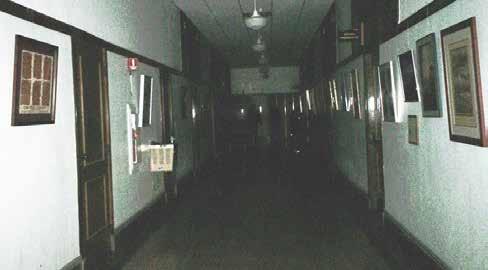

Spooky geology: A look at the mysterious ideas about stone and the paranormal
The Rio Grande Depot has been the subject of numerous haunting stories, most famously the legend of the “Purple Lady.” The Stone Tape theory attempts to explain why some locations seem to be more haunted than others.
By Collette Hayes c.hayes@mycityjournals.com
What if a building could remember every moment, every story and every experience that’s happened within its walls?
The Denver and Rio Grande Western Depot, constructed in 1910 in Salt Lake City, is known as one of the most beautiful and haunted buildings in Utah. Its exterior features a 5-foot-high base made of rare Colorado Yule marble complemented by brick and terra cotta above the marble base as well as a red tile roof. The interior of the depot is adorned with elegant marble finishes sourced from Kansas City. The combination of brick and stone construction provides the perfect medium for residual hauntings, which are often explained by the Stone Tape Theory. This theory suggests certain materials can “record” events that occur around them, serving as a common explanation for ghost sightings and apparitions.
The pseudoscientific Stone Tape Theory suggests that traumatic events can leave an imprint in stone, rock and brick. These materials are believed to be particularly effective at recording past events, which then can be “played back” like a recording. Limestone is considered the most effective of these materials. Marble, being a metamorphic rock derived from limestone, shares similar chemical properties, making it also highly effective in capturing past events. Sensitive individuals may be more attuned to the energy emanating from the stone in buildings, which could explain why only some people have experienced paranormal activity in the Rio Grande Depot.
The Stone Tape theory attempts to explain why certain locations seem to be more haunted than others, as well as why similar events tend to repeat in specific hauntings. It also provides insight into a common type of
paranormal experience. Witnesses at the depot have reported seeing figures engaged in their daily activities, hearing disembodied sounds such as footsteps running down the hall, doors slamming, an emergency telephone ringing at 3 a.m., and lights turning on and off. Additionally, there have been sightings of a distressed woman dressed in purple in the second-floor ladies’ restroom, who has also been seen frequently near the café.
“While working in the Rio Grande offices, I never personally experienced anything out of the ordinary,” Deputy Director of the Utah Historical Society Kevin Fayles said in a recent conversation. “However, others have reported hearing the sound of running footsteps in the basement hallway. Also, I have an image of purple mist on the mirror in the ladies’ restroom, taken by a former employee. Another photo I have is looking down a hallway, where you see three faint figures. The building’s age could contribute to the feeling that it is haunted. I definitely wouldn’t want to be alone in the building at night.”
The Stone Tape Theory is compelling, but is backed by little scientific evidence. However, it does offer some explanation as to why individuals who have worked at the Rio Grande Depot have experienced similar events in the exact same locations.
An employee told Fayles that the Purple Lady was the creation of a former historical society colleague who had worked there long before Fayles took a position with the society. Apparently, the woman who invented the story believed that every train station should have a legendary ghost story. So, she fabricated a tale about a raven-haired beauty dressed in a purple pillbox hat, dress and matching heels. The story goes that the woman died under a train while trying to retrieve her engagement ring, that had been thrown on the tracks by her angry lover.
As reported in local media, the building has been the subject of numerous investigations including ghost hunters, psychic mediums and a séance performed by a Wiccan. The investigative findings fell a bit short of explaining the strange occurrences experienced by several employees at the Rio Grande Café.
Cafe staff have reported unusual incidents, such as hearing a woman singing in the
bathroom when the building was closed, experiencing flickering and turning off of lights, and receiving a 3 a.m. call from an emergency phone located in an empty elevator.
Also, Utah Department of Heritage & Arts Communication Director of Communications Josh Loftin noted that people have reported hearing footsteps on the upstairs balcony, sounds of talking or music playing, ghostly sightings upstairs and even alarms going off unexpectedly.
Paranormal historian Troy Taylor, author of more than 150 books on history, hauntings, true crime and host of the popular podcast “American Hauntings,” suggests that the vast majority of the paranormal cases he has been involved in have perfectly natural explanations. He says, “It is easy to feed off one another’s fears and literally ‘invent’ a haunted house.”
Although he admits, “I have been involved in some cases that did puzzle me and left me feeling that the location really was haunted.” He says to keep in mind, “When investigating a paranormal event, activity rarely occurs during an investigation.”
Residual hauntings can attempt to explain most of the haunting activities that have been reported at the depot. Digging a little deeper, though, what about the water taps that turn on and refuse to turn off, reported by an employee or the Rio Grande Depot Café employee who said she was repeatedly locked out of the building late at night with no explanation, or cold spots in the building with no apparent cause for the low temperature? And the most pressing question: Will the new renovation of the depot stir up even more haunting activity?
Jeff Hymas, Utah Department of Government Operations executive communications director said, “For more than five years, extensive efforts have been undertaken at the Rio Grande Depot to assess the damage caused by a March 2020 earthquake, and to make the necessary repairs. As part of this process, the Utah Division of Facilities Construction and Management is working to ensure the restoration of the building’s structural integrity and to protect against future seismic activity. The building remains closed to the public while construction activities continue.”
According to paranormal belief, reno-
vations in a haunted building can sometimes disturb spirits and lead to a significant increase in paranormal activity. While there is no scientific evidence to support this idea, many homeowners have shared ghost stories that describe this phenomenon. One common theory is that renovations can unsettle spirits that are attached to the building. The changes may feel like an invasion to an entity that considers the building its home, leading to the spirit becoming restless or agitated.
On January 7, 2021, Adrienne White, owner of House Genealogy, began renovating her newly purchased historic home in Sugar House. While working in the basement, White and her sister encountered an inexplicable, almost paranormal, occurrence: an unidentifiable noise resonated through the house. Quickly returning upstairs, they found nothing out of place nor evidence of an intruder. The experience prompted her sister to search for information about White’s home, which led to the discovery of an obituary for a woman who had passed in the house on January 7, 1976— exactly 45 years from the day the renovation had begun.
“I’m not a nonbeliever in paranormal activity, but I don’t believe 100% either. However, my sister sending me the obituary changed my life,” White said. “It sparked my curiosity about the people and events that came before us, prompting me to explore the history of my home and other homes throughout the city. Amazed and fulfilled by what I uncovered about my home, I launched House Genealogy in February 2022.”
According to Jerod Johnson, a principal for the structural engineering firm Reavley Engineers, the Rio Grande Depot suffered severe damage from the 5.7 magnitude earthquake in 2020. Those involved in the renovation project have stated it could require “several years” to complete.
It may be quite some time before it is known whether the Rio Grande Depot experiences a significant increase in paranormal activity as a result of the current renovation. When the doors reopen to the Rio Grande Depot, the suspense surrounding this possibility will welcome both the curious and the brave to explore its intriguing hauntings further. l
An image of purple mist on the mirror in the ladies’ restroom, taken by a former Utah Historical Society employee. (Photo courtesy Kevin Fayles)
Looking down a basement hallway, where three faint figures are visible. (Photo courtesy Kevin Fayles)
Superintendent Hart’s first test: Navigating uncertainty in week one
State’s top educator remains agile during shifts in education reform.
By Peri Kinder peri.k@thecityjournals.com
Week one didn’t go as expected. Utah’s new State Superintendent of Public Instruction Molly Hart faced an unexpected challenge when President Donald Trump’s administration froze education funds that were set to be dispersed.
“It was surprising he froze funds that had already been approved through Congress,” she said. “I was anticipating changes, but I was anticipating them moving forward. So, when those changes happened a week into my tenure, it threw a wrench in the kickoff.”
Hart, who previously served as executive director of Summit Academy Schools for two and one-half years, hadn’t planned to follow in the footsteps of former superintendent Sydnee Dickson, who served for nine years. At Summit and as vice chair of the Utah State Board of Education, she felt she had found her place—working directly with students and leading through change.
“When opportunity comes, you got to answer the door,” said the veteran educator from Sandy. “I didn’t ever really see myself leaving a school setting where there were kids and I could be involved in an actual school day. I thought I hit the sweet spot, but opportunity knocks and to make a difference at this level, and to make things happen, how do you turn that down? It’s an exciting opportunity.”
It’s now been two months since Hart, a former teacher who served as principal at Mt. Jordan and Albion middle schools, was sworn in as state superintendent. She and Dickson collaborated to ensure a smooth transition in June into the K–12 summer break.
“I stay moving from 7 a.m. to 7 p.m. I haven’t even unpacked all my boxes. It’s back to school for USBE, just as it’s back to school for schools,” Hart said.
City Journals posed questions to Hart about key initiatives and pressing issues in education.
What was it like when the government froze funds?
The president was clear about his prior-
ities all the way along. We did eventually get those funds, so districts are able to pay their summer programs’ and afterschool programs’ people.
A central tenet of Trump’s plan is to eliminate the federal department of education. Is it going to impact some of the programs, such as Title I schools and others?
There are three big federal education programs: the free and reduced lunch program, the Title I program and IDEA (Individuals with Disabilities Education Act) or special education. USDA already co-manages the lunch program along with department of education. The plan for the others, at one point, was to move them to other agencies, and the funding was to continue in some form. But other Title programs, like Title II (supporting effective instruction), Title III (language instruction for English learners and immigrant students) were the ones that were frozen. We’re now looking at the budget process moving forward for when we get federal funds. There are a lot of different timelines that intersect, and the U.S. Senate pushed back against some of the president’s proposals, so it’s just an evolving story with a shifting landscape. We have to stay agile, consider the information we have at any given time and be ready to improvise.
If the federal department of education fades away, is Utah OK to run our education system?
Many people don’t think it will completely fade away. The department of education may still exist, but it could be much smaller in size and scope. It would take congressional action for the department to “disappear.” Saying that, it was nowhere on my bingo card that funds would be frozen. And, there was nowhere on my bingo card that those funds would be unfrozen. What’s extraordinary about these times is the different paths and the uncertainty of the next action. The best thing I can do is help others prepare for contingencies. Utah is well positioned to manage and keep consistent educational opportunities for kids. The problem is always where the money comes from, when the money comes, and how the money comes, so whether it comes from the state or from local, or from federal, and how it comes, what kinds of strings are attached, what kinds of choices we get to make, and how it’s administered. It’s a new game — and all those spaces are changing at the

same time. At the end of the day, our teachers and principals are going to open schools this fall, and they are going to give students the best education out there.
Share your top priorities.

Molly Hart, now the state superintendent, received directions how to drive the excavator into the former Mt. Jordan school building to make way for a new school. (Julie Slama/City Journals)
It’s important to me that we get the various constituents together. There’s been a fracturing of communication in education, and we’ve become very polarized needlessly. As state superintendent, I can bring disparate groups of people together and create synergy. It’s important the USBE is responsive, efficient and meeting the needs of the various stakeholders and also, communicating accurate data and information to the legislature, to the field and throughout the agency. It’s important we find ways to increase student achievement and knowledge and students come away knowing how to solve problems and knowing how to meet the needs of communities in the future. That is our goal and it’s important to me that stakeholders come together and keep that in our sights. We’re an agency of the government. We serve the people. We are servant leaders. We need to do that efficiently and without wasting resources, and we need to do it transparently.
Utah has 70,000 students. Many teachers and principals are concerned about low attendance. How can USBE help?
Attendance is one of those things that can’t be solved with any one single approach. We’ve got to engage families and parents and understand why students aren’t coming to school and figure out where that disconnect is, and work on the experiences in school so that it’s a place students understand the need and what they get out of being there. It’s got to come from not just the education community, but communities at large and at the individual level. It is individual students and their
parents making a choice each day whether or not they’re going to attend. We’ve got a toolbox to support districts as they identify barriers and work to remove them. As a former principal, I do know there’s a lot a school can do, but I also understand the limitations of what a school can do and where a district or a state agency or the legislature or a community agency can have considerable impact on student rights and attendance rates. One thing we can do is look at schools at higher attendance rates and figure out what’s different between those and schools where attendance is an issue. There’s just a lot packed into attendance. It’s not simply missing a resource like a textbook. We need to look at everything. Does it have to do with transportation? Does it have to do with illness? Does it have to do with online learning? Is it a family priority or is there a barrier? Could it also be a data issue? There are a lot of questions to be answered.
What are some challenges facing our students in schools?
The changing workforce and what the workforce is going to need and what students are going to need to be prepared for the workforce is a challenge. Education spends a lot of time working with workforce, higher ed and workforce services industry partners to understand their needs, what they’d like to see our graduates be equipped with. A couple years ago, students were studying computer programming or data science and there were 1 million jobs. Well, here comes AI, and maybe some of those pieces can be outsourced, and the data scientist needs to have a whole different set of skills. That rate of change is accelerating, so it’s always a moving target. There’s a lot of movement of students geographically and making sure students information get from point A to point B safely, so there’s continuity in services and students can
Seen here as principal of Albion Middle in 2023, Molly Hart plans to make it a point to listen to families, teachers and others as state superintendent of instruction. (Julie Slama/City Journals)
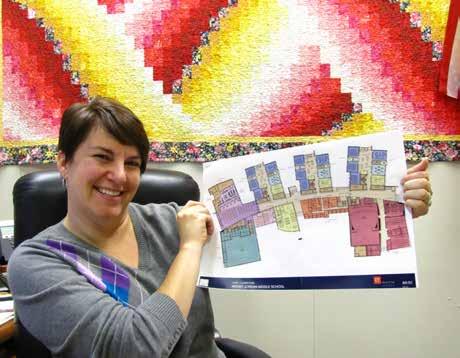
pick up where they leave off, pick up in one place where they leave off in another. That’s a challenge as well.
You have said as an educator, you love hearing from parents, getting feedback and having those conversations. How are you going to do it now?
I’m working on creating listening groups and listening tours. As the school year gets started, I’ll be traveling around, coordinating and attending focus group meetings, along with state board members and legislators and community partners and districts, intentionally hearing those (parents’) voices and asking those questions. My plan is to ask the local legislators, the local board members and the state board member to be part of it and make sure as many people want to attend, can attend. There would be two meetings in the same community — one to listen to parents and hearing what they have to say, and then a second, listening to teachers and educators to get feedback there. (Once set, the schedule will be posted on the USBE website and communicated through local districts and through school community councils.)
Utah spends less than $10,000 per student (ranked last in the country). Is more needed? If so, how are you going to get more and what is it needed for?
That is a huge question. We have to live within our means and if that’s what we get, then that’s what we get. We can’t spend more. Of course, we could use more, but it’s government money, which means it came from the people, so every time we ask for more, we’re asking people for it from their wallet. What’s most important is that we’re using the money we do have in the best way possible. I can ask, ‘What are we getting for the money that we do
From costumes to candy: The safety checklist every family needs
Halloween Safety 101: The Essential Guide for Parents and Homeowners
By Holly Curby hello@hollycurby.com
With Halloween right around the corner, families are busy planning costumes, buying candy and decorating their homes. But amidst the excitement, safety should be a top priority. This festive night—meant for costumes and candy—can quickly take a dangerous turn if precautions aren’t taken. According to safety experts Judy Chavez from the U.S. Consumer Product Safety Commission and Amy Bryant, Crime Prevention Specialist with Sandy City Police, Halloween is one of the riskiest nights of the year for children and families.
Here’s how you can enjoy the frightful fun without real scares.
Costume Safety: Keep it Fun and FlameFree

Consider having packages delivered:
• To your workplace
• To a trusted neighbor
• To a secure community locker
spend? Are there things we’re spending more on, that maybe were needs of the past, but are not current needs?’ We need to make sure money is going to the right places. We want to use the money we do have in the best way possible for the best outcome to set up our students for success, whatever success looks like for them and their families.
Utah students are pushing graduation rates close to 90%; how does that compare to national standards?
It’s amazing. When I go to national activities or conferences or gatherings, Utah has the envy of a lot of states. At a national conference, one of our staff members shared our teacher retention rate (91% average retained in a single year) and people in the room gasped. We are doing really great things in Utah and I’m proud of the work we do in our communities and at our state level, but you just don’t settle. You just don’t. We’re going to keep on doing great things for our kids and as new situations and new realities emerge in our communities and in our workforce, then we adjust our practices accordingly. We keep looking forward for those opportunities and those teachable moments.
Utah is ahead of the national average on test scores. Can Utah students do better?
I’m very proud of the work our families and students do. Of course, we can do better, and, of course, I want them to do better and I’m going to push them to do better. There’s always room to grow. I like to be a little relentless with pushing everyone to be better; we don’t ever quit on kids. We keep moving forward and putting one foot in front of the other. I’m never going to say, ‘We’ve arrived’ and ‘It’s good enough.’ l
“Costumes should fit properly—not too long, loose or baggy,” Chavez said. “Long, flowing fabric can lead to trips and falls or even become a fire hazard if it brushes up against open flames like in Jack-o’-lanterns.”
When choosing costumes:
• Opt for flame-resistant materials like polyester or nylon.
• Avoid sheer cotton or rayon, which are more flammable.
• Add reflective tape or glow sticks to ensure visibility at night.
• Use hypoallergenic makeup and remember to remove it before bedtime—especially for kids with sensitive skin.
Chavez added, “Costume safety isn’t just about fire. It’s about preventing falls, rashes and other injuries we see every Halloween.”
Home Security: Don’t Let the Wrong Goblin In
Bryant reminds homeowners that Halloween isn’t just busy for trick-or-treaters—criminals may be lurking, too. “Keep all doors and windows locked, whether you’re home or not,” Bryant said. “Don’t assume because it’s a family night that everyone has good intentions.”
Other tips:
• Don’t open the door to strangers if you’re not expecting them.
• Teach kids not to answer the door without an adult’s permission.
• Install deadbolt locks with a 1.5-inch throw for added security.
• Use long screws in strike plates for stronger resistance to forced entry. And don’t forget the garage. “Garage doors left open are an open invitation,” Bryant said. “Close and lock them—and if you’re going out of town, unplug the garage opener entirely.”
Porch Pirates Beware: Protect Your Packages
Halloween kicks off the holiday season, which often includes more online shopping and deliveries. “Track your packages and get them off the porch as soon as they arrive,” Bryant said. “Porch pirates are waiting for a chance to snatch them.”
Also, let trusted neighbors know if you’ll be out of town. “They can keep an eye on things, collect packages, and even roll out your trash bins to make it look like you’re home,” she added. Trick-or-Treating: Safety on the Streets
Trick-or-treating is a highlight of Halloween—but it also poses risks, especially after dark.
Bryant emphasized: “An adult should always accompany children. Even if they think they’re old enough, parents need to be nearby.” According to Chavez, the CPSC estimates 3,600 Halloween-related injuries occurred in recent years, many due to falls, allergic reactions and decoration-related accidents.
To stay safe:
• Use sidewalks and crosswalks—never jaywalk.
• Make eye contact with drivers before crossing.
• Equip costumes with flashlights, glow sticks or reflective gear.
• Choose well-lit neighborhoods and avoid poorly lit areas.
“Motorists, too, need to do their part,” Bryant said. “Drive slowly, keep headlights on, and be extra cautious in residential areas.”
Don’t Let Decorations Become a Disaster That adorable Jack-o’-lantern on your porch? It might be a fire risk.
“If you use candles, never leave them unattended,” Chavez said. “Better yet, opt for battery-operated LED candles.”
Also:
• Bring in pumpkins and outdoor décor at the end of the night.
• Avoid leaving anything out that can be vandalized or used dangerously.
• Monitor any electrical decorations for exposed wires or overloading outlets. Have Fun, Stay Safe
Halloween is meant to be fun—not hazardous. With the right precautions, families can enjoy the thrills of the season without becoming part of the injury statistics. As Chavez puts it, “It’s about making smart choices. We want Halloween to be memorable for the right reasons.” l
With a history of involving all stakeholders, Molly Hart shares final plans for the new Mt. Jordan Middle School in 2013. (Julie Slama/City Journals)
Pirate costumes prepped for a safe night of trick-ortreating (photo credits: Jim Harding)
The Power of Human Connection in Salt Lake County
states in the na-
yet our residents also report some of the
feelings of loneliness. State health surveys show that nearly one in four Utah teens in 2023 and about 6% of adults in 2021 said they often or always felt, “People are around me but not with me.” That’s a sobering reminder that being surrounded by people is not the same as feeling connected to them.
The U.S. Surgeon General defines loneliness as the distress of not having adequate meaningful connections, while social isolation is the objective lack of social roles, relationships or interaction. Both are harmful. Loneliness raises the risk of premature death by 26%, and social isolation by 29%. Utah data show youth are particularly vulnerable, with loneliness peaking around 10th grade. At the other end of life, older adults may report less loneliness, but many live alone or are less socially active, leaving them isolated—and at increased health risk—even if they say they feel fine.
It’s not all bad news. Among adults, reported loneliness has risen from 5% in 2019 to 16% in 2024. While that increase seems alarming, some experts believe it reflects growing awareness. More people are recognizing that connection matters, which may encourage them to seek help or create new relationships. Meanwhile, Utah’s highest years for suicides (2017) and overdose deaths (2022) are behind us, with rates trending slightly down. We should not ignore loneliness, but perhaps our awareness is a hopeful
Aimee Winder Newton
Salt Lake County Councilmember| District 3

step toward stronger, healthier communities. Addressing loneliness requires all of us.
Parents can set the stage at home by turning off screens, setting aside phones, listening closely, and modeling the conversations they hope their children will have with others.
Simple family meals and one-on-one time give youth safe spaces to share what they’re really experiencing.
Schools and businesses also play a role. Policies that encourage real connection—team projects, buddy systems, carpools, phonefree zones or mentoring programs—help students and employees build relationships that strengthen both well-being and performance. Identifying at-risk youth early and linking them with mentors can make a world of difference.
Local governments can create environments where connection naturally happens. Parks, libraries, recreation centers and public transportation all serve as “third spaces” where neighbors can meet. Programs like Salt Lake
Better Shelves. Custom Solutions.

County’s Free Youth Rec Passes, summer events, farmers markets and free-fare zones lower barriers and invite people to gather. These aren’t just amenities; they are investments in the health and strength of our community.
Faith groups, sports teams and even traditions around food and gathering offer additional pathways. Whether it’s cheering together in the stands, sharing a meal or volunteering at church, these experiences weave the fabric of community life. With creativity, we can support system-level changes that expand these opportunities in healthy ways.
In the end, the responsibility rests with each of us. Teens can choose to include someone sitting alone. Adults can prioritize friendships, check in on a neighbor or carve out time for family. Older adults can accept invitations or invite others into their routines. Each of these choices is small, but collectively they build the kind of community Salt Lake County is known for—caring, connected and resilient.
So I encourage you to pause and ask yourself: Am I truly connecting or just surrounded? Whether you are a student, a parent, a business leader or a retiree, you have the power to strengthen the web of relationships that hold us all together. In Salt Lake County, our greatest strength doesn’t come from policies or programs alone—it comes from people. When we choose connection, we choose health, hope and a brighter future for our community.


A sweet slice of tradition
For nine years, Liberty Elementary’s PTA has welcomed students back with a refreshing treat.
By Julie Slama j.slama@mycityjournals.com
Beforethe school bell rang, signaling the end of the first day of school, Liberty Elementary volunteers were slicing up about 14 watermelons.
About 240 students, who had been buzzing with excitement for the first day to begin, were now just as thrilled for it to wrap up—and to get their hands on a slice or two of juicy watermelon.
“We’ve been doing the Watermelon Welcome for nine years now,” said PTA treasurer and past-president Amy Roberts. “It started when there was a solar eclipse on the first day of school, so the kids watched it and had watermelon. Since then, it has become a fun tradition.”
Roberts remembers that first year; she was there enjoying the eclipse and watermelon alongside her son, who is now in eighth grade.
“Our PTA usually finds watermelon donations. It’s something simple to do and the kids all love it,” she said.
Looking ahead, the PTA has several events planned, including a family carnival and fall festival, Red and White Ribbon weeks, a turkey trot, a holiday gift shop, plus the science fair, spelling bee, Reflections program and more. l





Liberty second-grader Kian Stram enjoys a tasty treat at Liberty Elementary’s traditional Watermelon Welcome, held after school on the first day of the school year. (Photo courtesy of Shana Mondragon/ Liberty Elementary)
Life and Laughter - Magic is a Superpower
Back in the day, it didn’t take much to be labeled a witch. Did you own a cat? Witch. Did you have a birthmark? Witch. Did you use herbs, wear a cape, know how to read or lure children into your gingerbread-flavored home so you could eat them for dinner? Witch.
I’m just saying, the bar was low. Starting in the 1450s, witch hysteria swept across Europe, lasting for centuries. Intense warfare, hardship, famine and disease meant only one thing: it was time to burn the witches, because obviously.
Nearly 60,000 people were tried and killed as witches. More than 80% were women and 60% were over the age of 40. It was a gendercide that wiped out generations of women. Many were healers, midwives, widows and property owners.
They’d reached a time in their lives where they were fine being alone, with maybe a cat or two. They just wanted a nice broom, a boiling cauldron of soup and a Pinterest board of “Witchy Reads.”
Many women step into their power once they hit 40, but give women power and there’s going to be trouble. Killing the older generations meant wisdom was lost forever, which is probably why we have mini golf sets for the toilet.
Like Labubu and Meta (and just as


diabolical), witch trials were big business. Women were arrested, property was seized and people flocked to churches because no one wants to accidentally sell their soul to Beelzebub.
The witch trials also created a disconnection between women; a fear of gathering, the angst of being seen as a “coven” when all you wanted to do was watch the “Real Housewives of Salem.” Women stopped socializing because having a friend for tea could end in a hanging. (And you thought your book club was stressful.)
I’m a lover of all things witchy, a devotee of strong women using their magic for good. A witch is a woman who speaks truth to power, without shame. Imagine a combination of Dolly Parton, Oprah Winfrey and Ruth Bader Ginsburg, a woman so powerful even the Puritans would have been like, “Nope, not today.”
You see, a witch hunt creates a cul-
ture that undervalues women. When you describe women as shrill, chatty, feisty, mousey, sassy, emotional, slutty, hysterical, irrational or hormonal, those words strip away power.
How many of these words are used to describe men? Almost zero. At the worst, men get labeled as “grumpy,” and somehow that becomes “distinguished.”
There’s still a witch hunt going on today. Saying “women’s rights” to certain groups triggers frothing at the mouth and a call for the ducking stool.
Women want to be believed, heard and have the ability to live without violence or discrimination. We want affordable physical and mental health care, an equal wage and respect. Is that insane, deranged, unhinged or any other word used to lock women up in asylums, as recently as 1967?
A witch stands on her own. She embraces her age, her knowledge and her intuition, without fear. It’s not surprising that interest in witchy practices is rising. You can learn spells on TikTok, craft a voodoo doll on YouTube and banish your ex to the depths of Detroit using a candle, cayenne pepper and a squeeze of lemon. Science, obviously.
For women who have felt disenfranchised in their communities, religions and

workplaces, witchy practices are a way to find their power. It isn’t an excuse to turn women into barbecue.
I associate magic with creation, and women are the ultimate creators. Women are magic, able to run empires, sing lullabies and look fabulous in a cape. Do you need someone to change the world for the better? Find a witch.


































